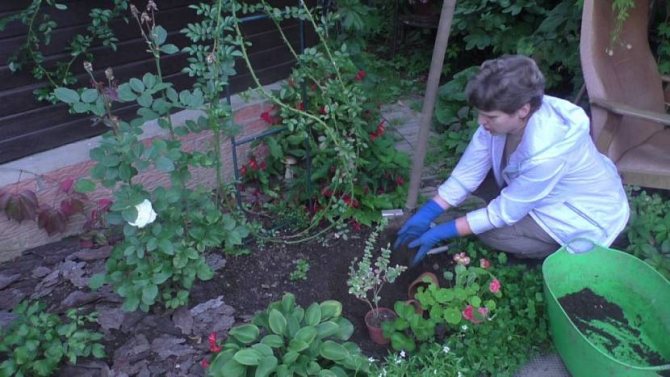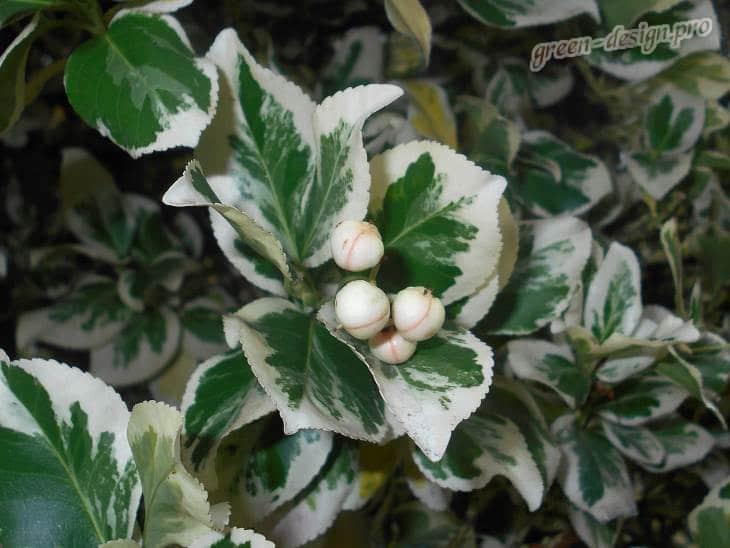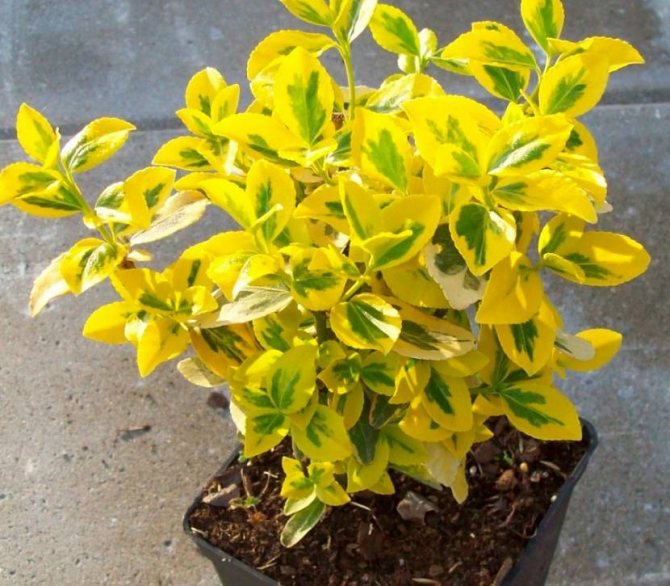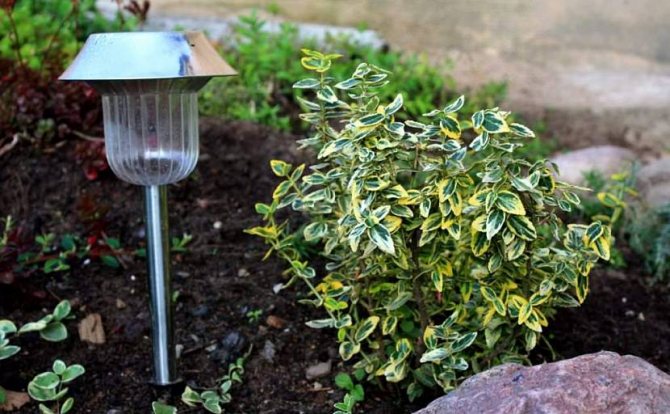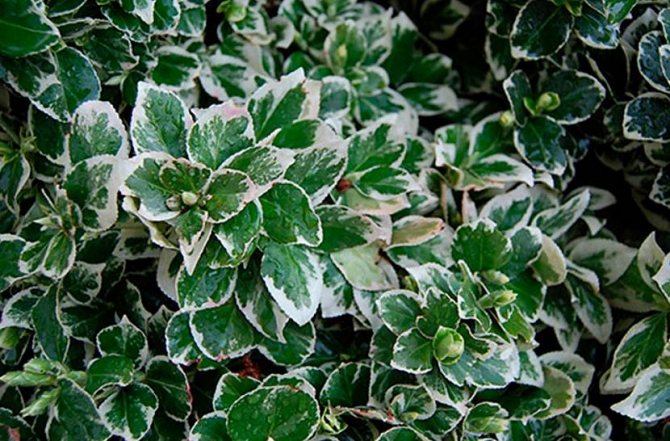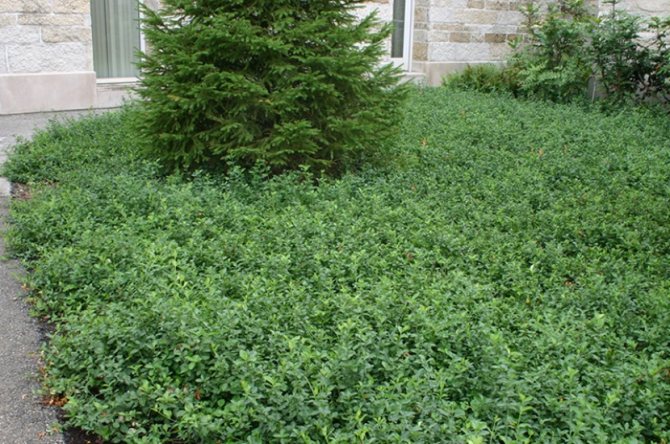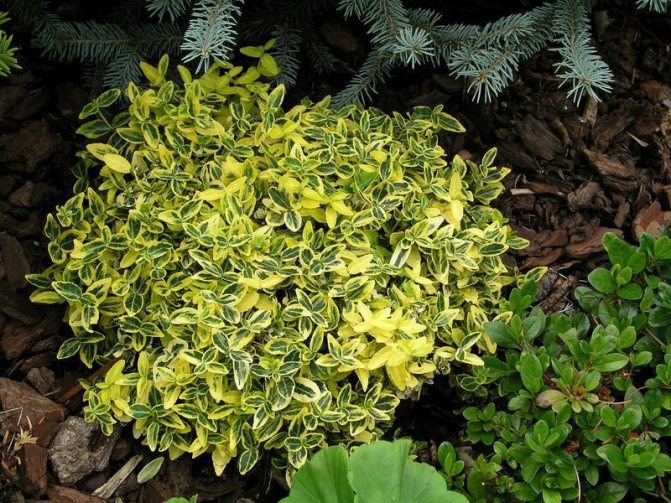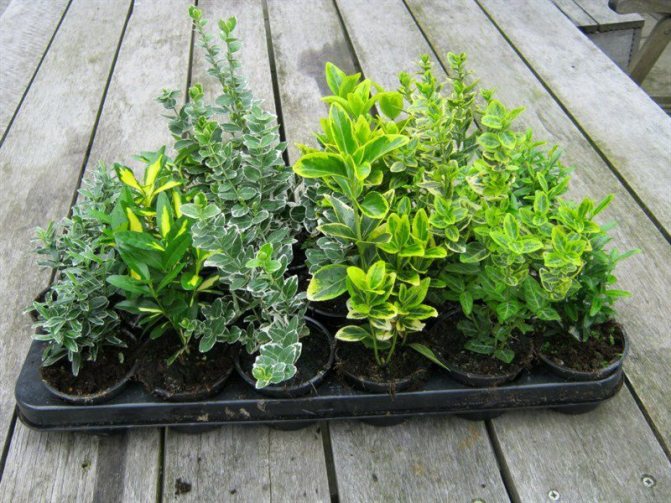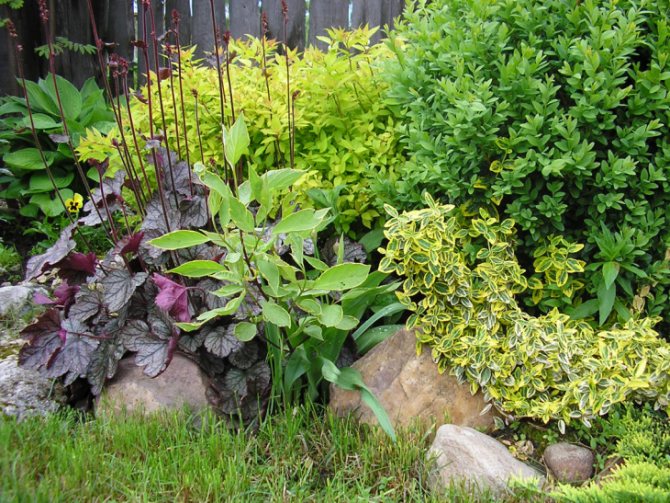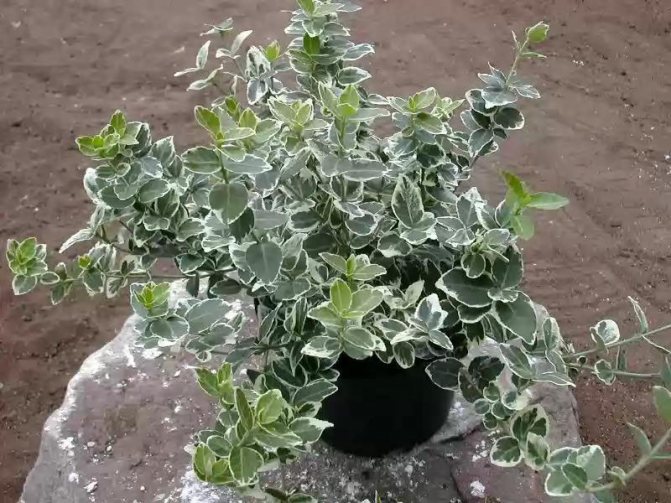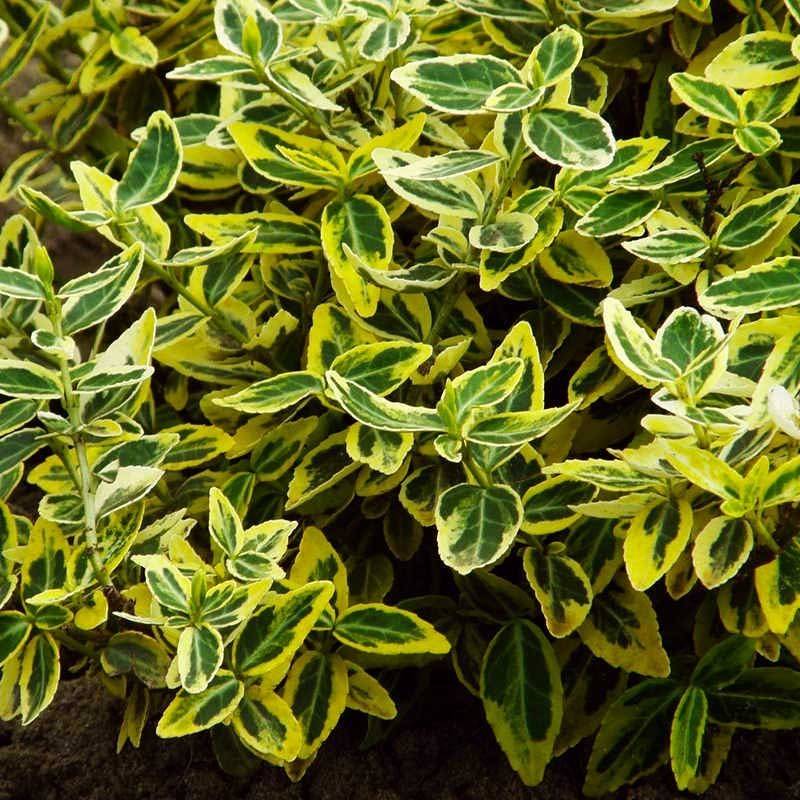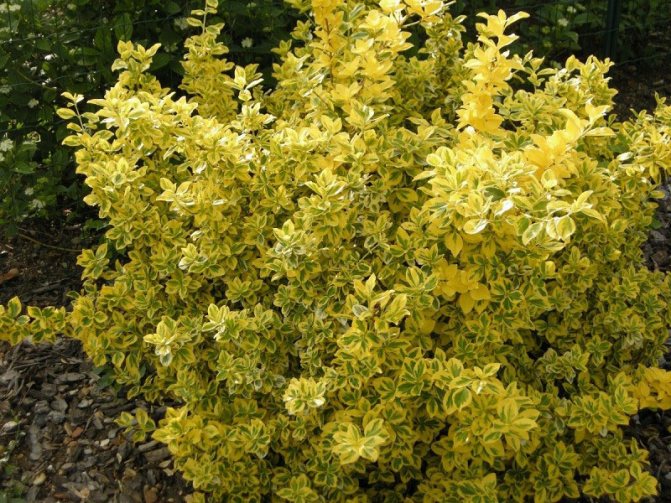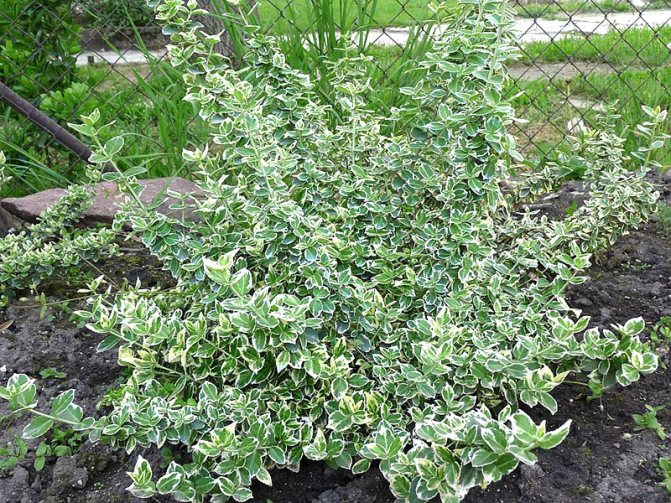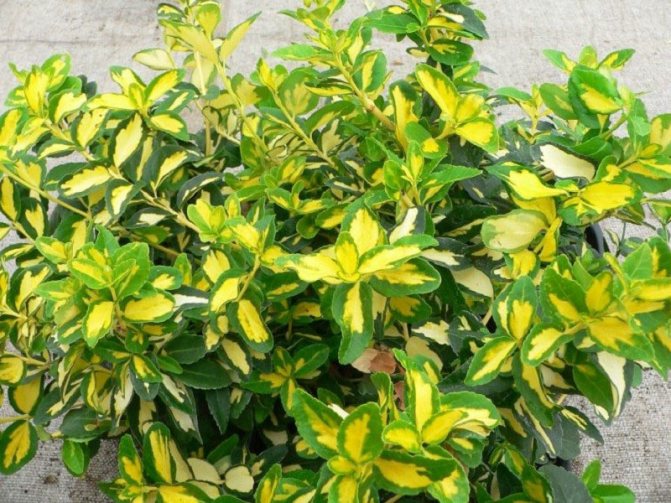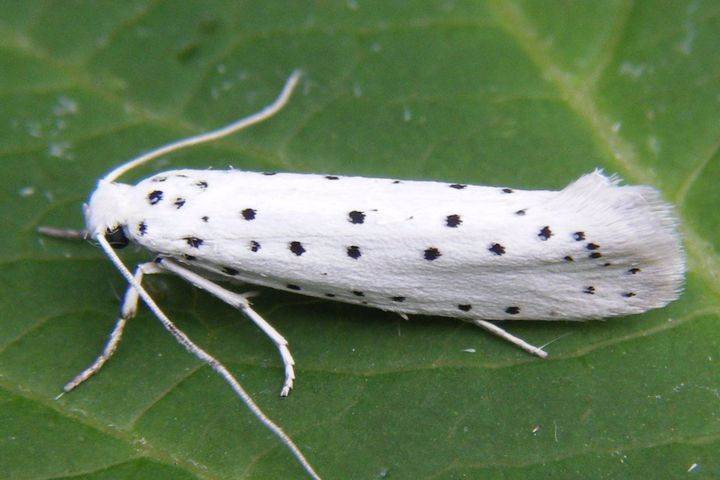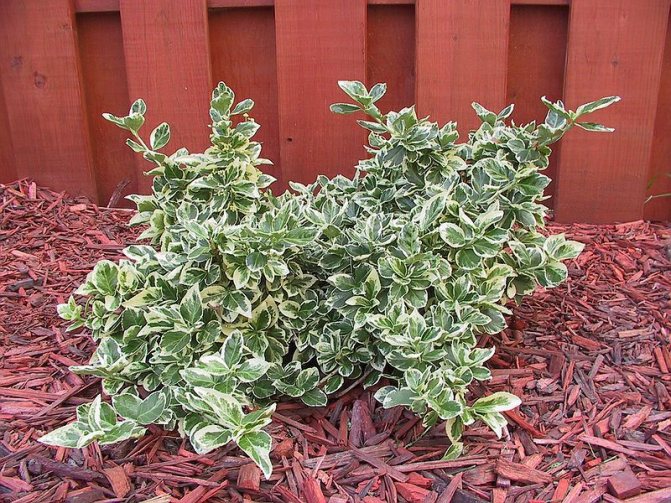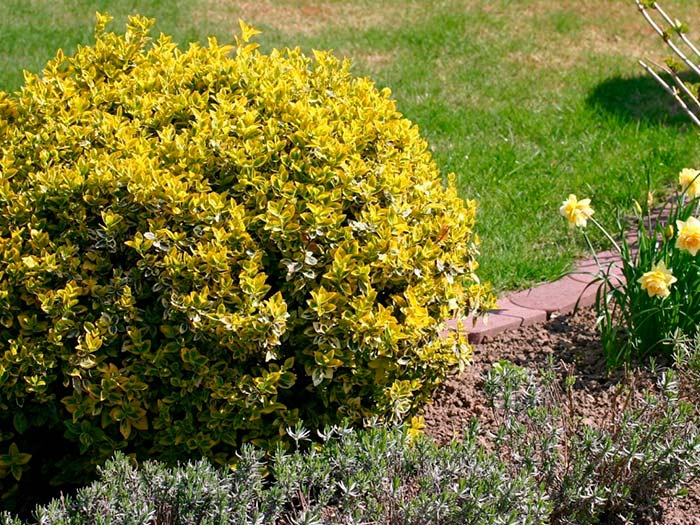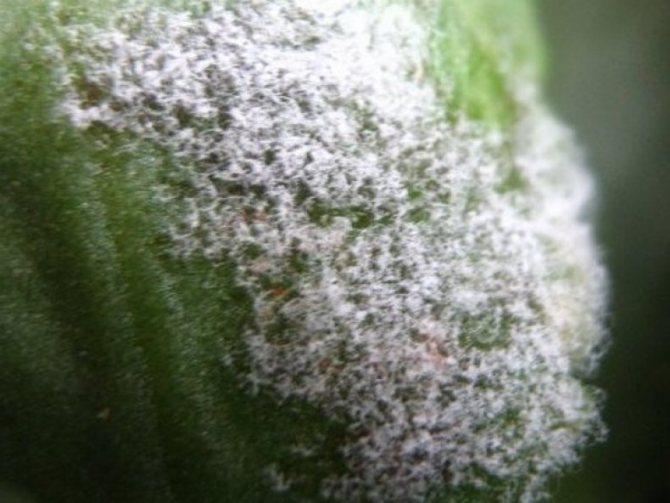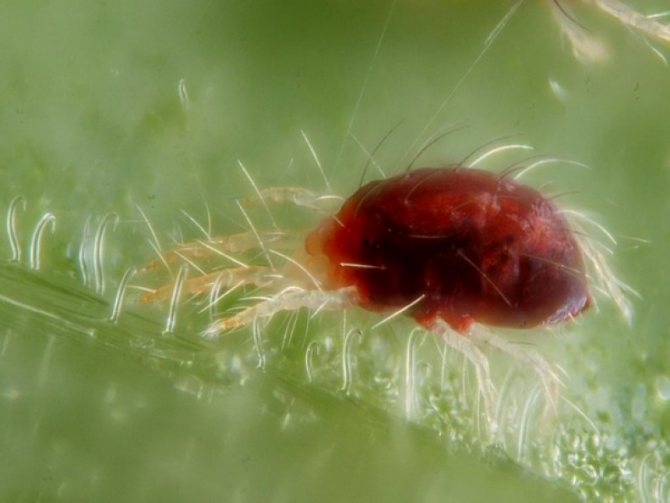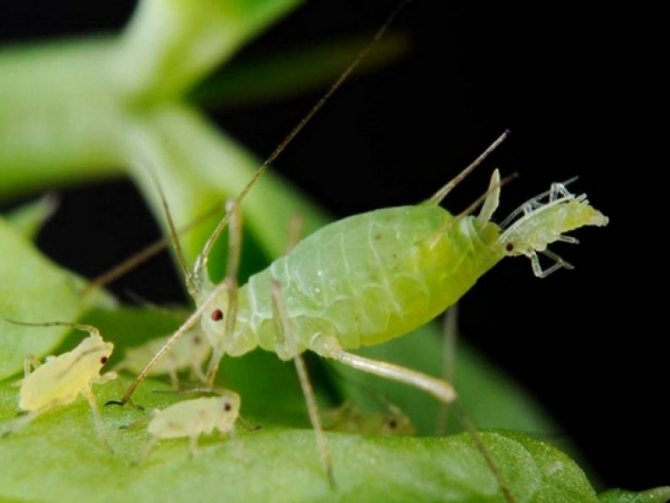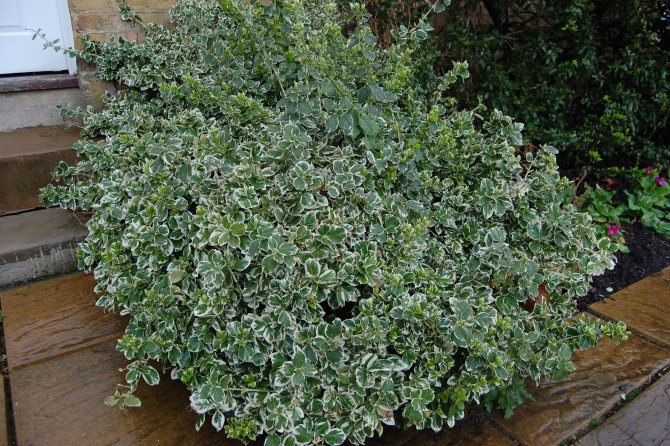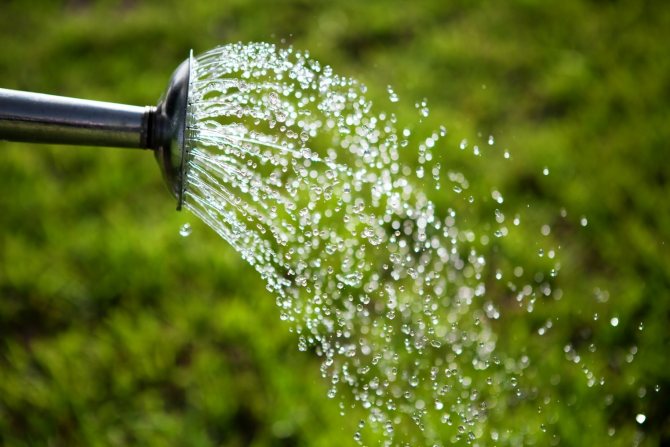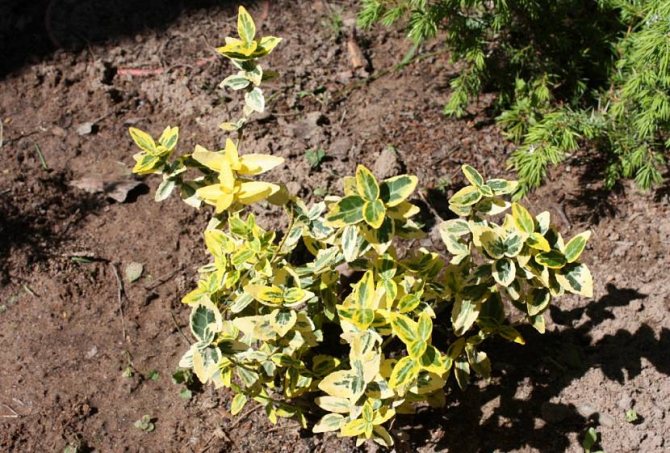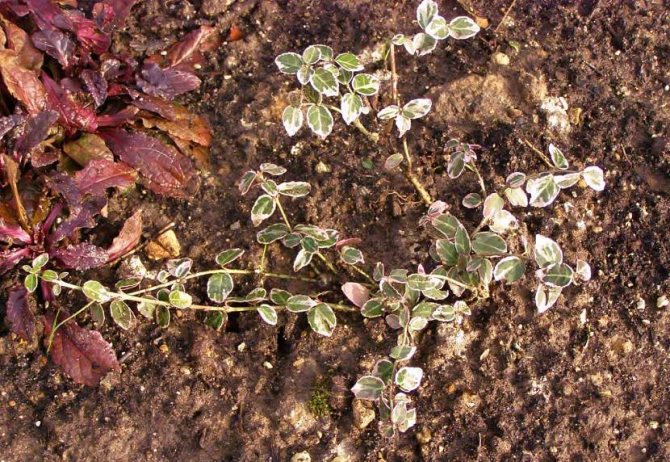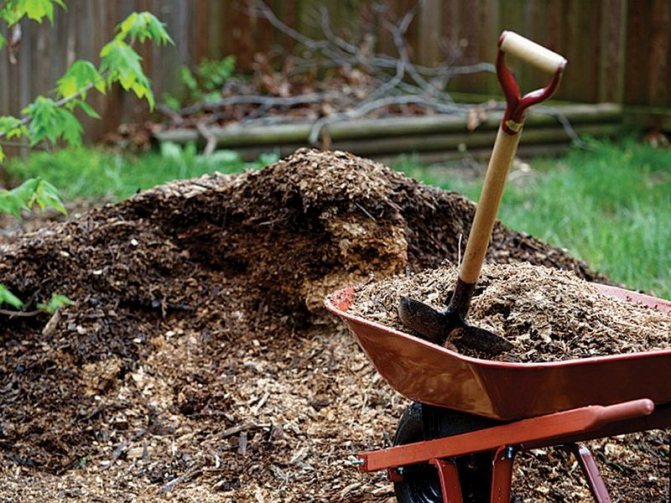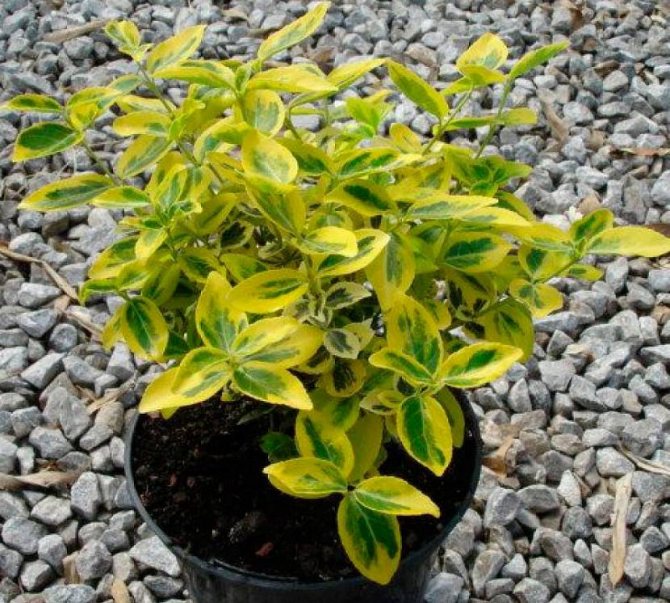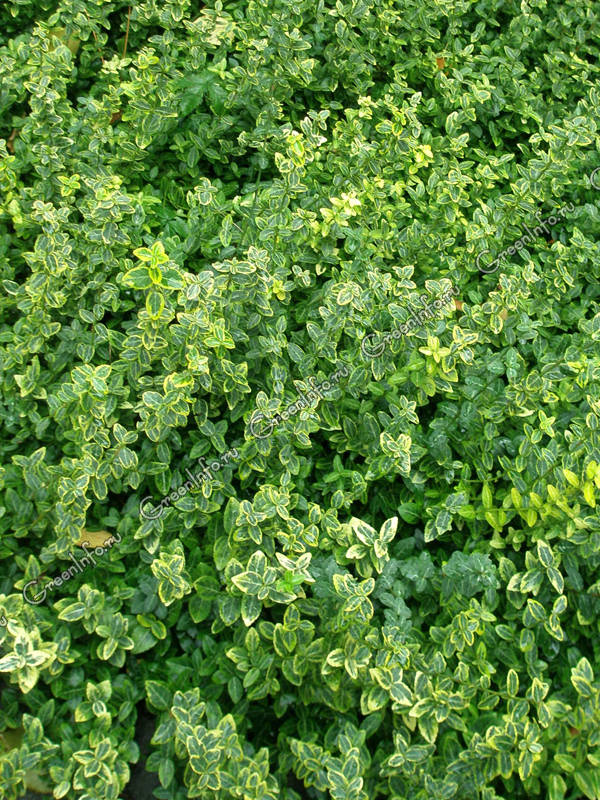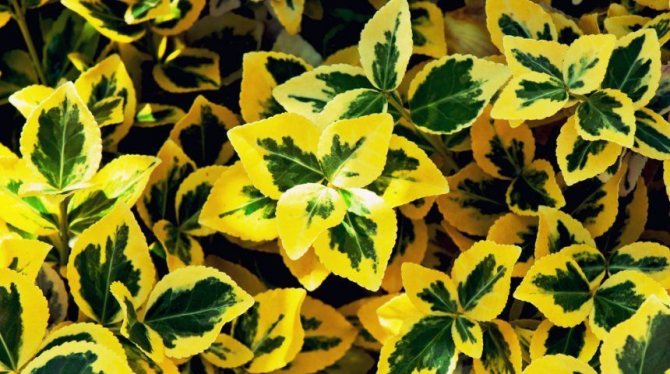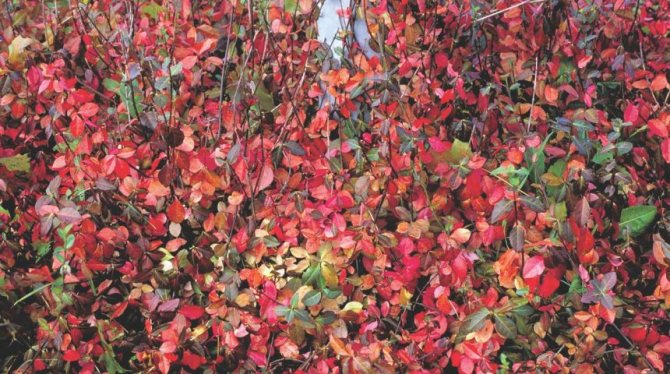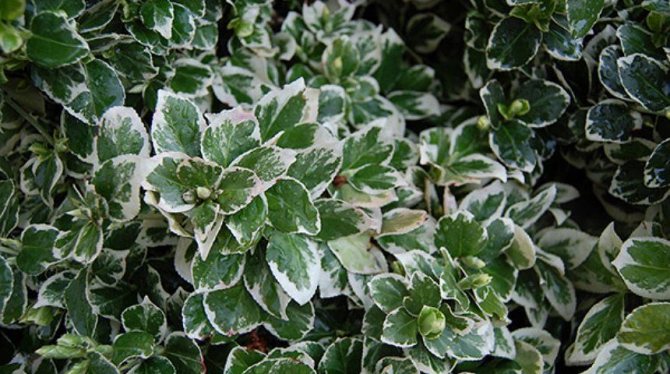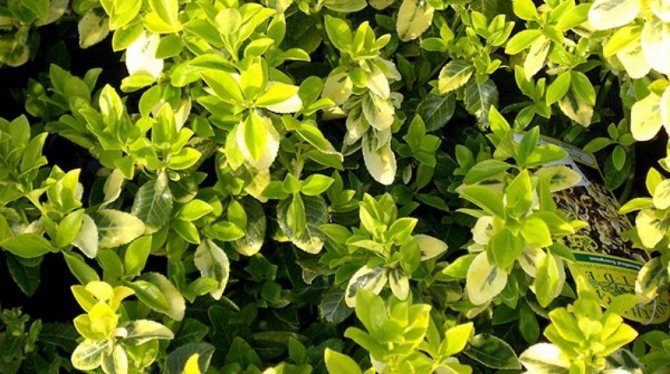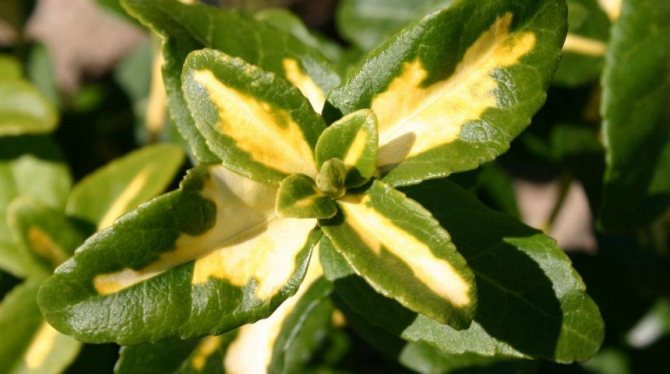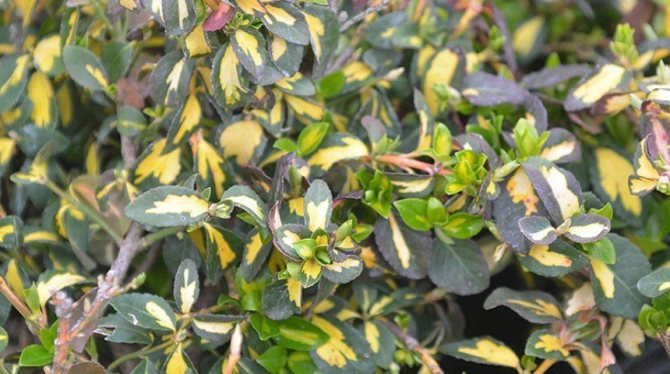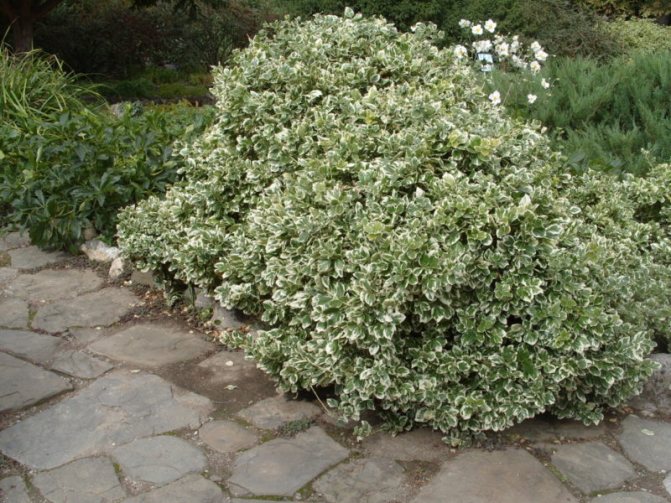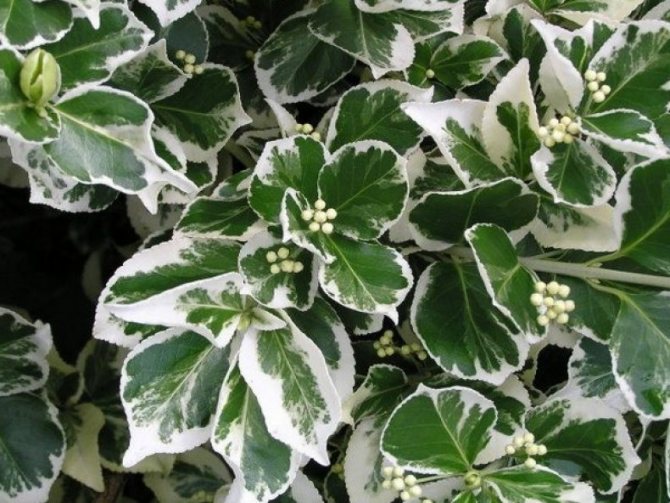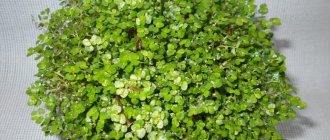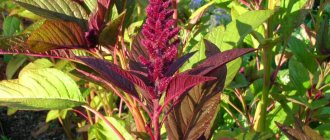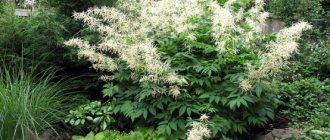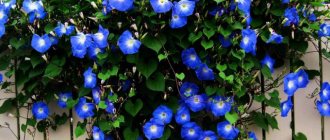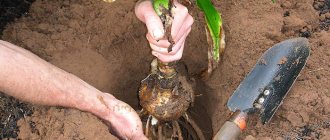Flower appearance
The very name of the variety - "emerald in gold" speaks of how this plant looks like. The description of euonymus fortunei emerald n gold is as follows: a dense shrub with harsh oval leaves of a two-color color. In this case, there is yellow along the edges of the sheet, and green in the middle. In winter, the shrub changes its yellowish tint to reddish brown.
The shrub blooms with inconspicuous (sometimes they are called dead flowers) of a pale yellow color. Then bright purple or pink fruits appear, which enliven the whole garden in September. Despite its slow growth, the shrub is able to climb up the support to a height of two meters. Thanks to this plant, you can create beautiful decorative compositions and decorate any garden.
Planting euonymus in open ground
The process of planting this shrub includes the following steps.
- Dig a hole with a depth exceeding the volume of the earthen clod of the seedling twice.
- Lay a thick drainage layer on the bottom. For this purpose, river gravel or the usual expanded clay will serve us. The thickness of the layer should be at least 15 cm, since the plant does not tolerate stagnation of water in the ground.
- Add a little peat, humus, sand and mineral fertilizers to the soil extracted from the hole.
- Place the seedling in the hole without deepening the root collar.
- Cover with prepared earth, compact.
- Water the seedling.
- Mulch the surface of the soil around the trunk with litter, sawdust or peat.
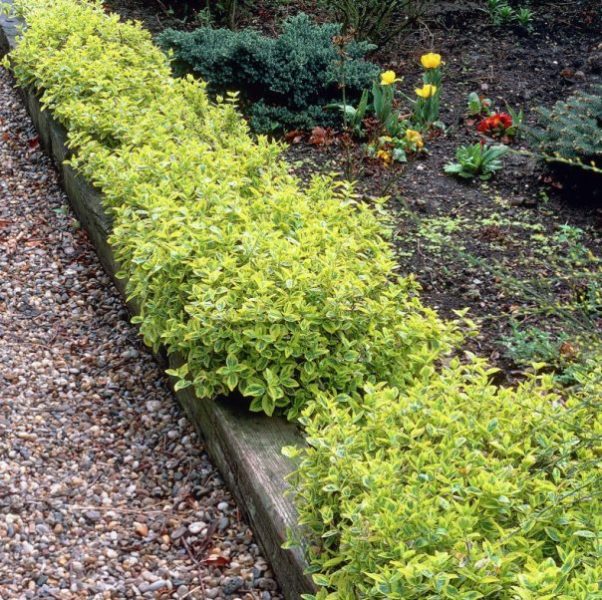
Fortchun euonymus hedge
Planting and leaving
In principle, it is not difficult to take care of the shrub, the main thing is to remember some recommendations regarding the quality of the soil and its loosening, watering.
They are as follows:
- The soil.
Since the root system is superficial, it is quite sensitive to rough soil and any damage, so you need to take care of it carefully. In order for the plant to please with early flowering, it is necessary to plant the shrub in loamy soil (not dense). It is also important to regularly loosen the soil in order to provide oxygen supply. This should be done 3-4 days after the soil is moistened. The plant will not survive stagnant water, so it is important to provide high-quality drainage in order to further exclude the possibility of root decay. To do this, expanded clay or pebbles must be poured into the hole, before planting. - Lighting.
The shrub can grow calmly both in the sun and in the shade. It is considered optimal to choose a place where the sun shines part of the day, and the second - partial shade occurs. In this case, the plant will develop normally and the brightness of the color will not fade. In especially hot regions, it is advisable to create artificially diffused light at noon so that the leaves do not get burned. - Watering.
Fortune's euonymus Emerald Gold is picky about moisture. Therefore, the young plant should be watered as often as possible. An adult shrub is not so picky, therefore, the frequency of soil moisture can be slightly reduced. In a hot period of time, it is recommended to fill the plant 2 times a week. The more often the flower is moistened in the spring, the faster it will wake up from winter frosts. - Top dressing.
For high-quality and long-lasting flowering, euonymus must be fertilized.For feeding in the spring (April-May), you can use complex mineral fertilizers. Compost is also fine. In the fall, fertilizers rich in potassium and phosphorus should be applied to the soil. Thanks to them, the shrub will be nourished and will be able to gain strength during the winter. In addition, it is recommended to mulch the soil with dense bushes. - Wintering.
Emerald Gold belongs to frost-resistant plants and is able to withstand up to -25 degrees Celsius. At the same time, it is better to prepare young flowers for wintering so that they do not die. To do this, it is enough to cover the vines with dry foliage in a 20 cm layer. If desired, you can cover it with spruce branches, but for this variety of euonymus, such a procedure is optional.
Shrub planting has the following features:
- The hole is dug twice as much as the root system of the seedling.
- The bottom is laid with pebbles or expanded clay, and the earth itself is mixed with compost.
- The seedling should be lowered into a hole and covered with earth so that the root isthmus remains above the soil surface.
- It is important to form a watering hole around the plant.
- For replenishment, you can use mulch from bark or humus.
It is optimal to plant a shrub in the spring, or rather, at the end of April. Pruning. The plant needs to be pruned dry or protruding branches to give it a well-groomed appearance. In addition, it is with the help of trimming that you can form the desired crown. This procedure is carried out in early spring or already in the autumn.
Planting a plant: methods
In cool climates, ready-made seedlings are the only effective way to plant Fortune's spindle tree. The best time for breeding outdoors is from the second half of April and throughout the month. Some gardeners practice autumn planting, but this method of growing is more troublesome. It is better to plant dwarf varieties in containers, bringing them indoors for the winter.
The culture loves a neutral soil composition. Acidic soil is contraindicated for her. The soil should be light, loose and nutritious. The degree of illumination required depends on the variety. Most of them prefer midday partial shade. Spotted species are more fond of the abundance of the sun.
Attention! Keep in mind that in the open ground, the euonymus will quickly expand in breadth.
Having found a suitable place on the site, dig a hole. It is important to do this a couple of weeks before planting. The size of the hole is 2 times the size of the rhizome:
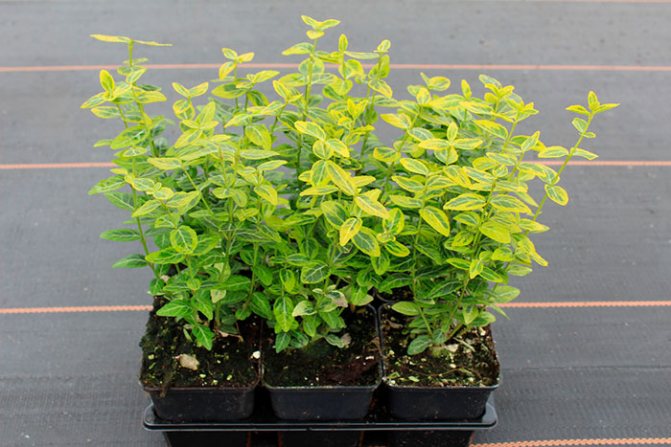
Saplings of euonymus
- Pour a layer of sand at the bottom. Mix the removed soil with compost and complex mineral fertilizer.
- Place the seedling in the center of the hole. Bury with prepared soil.
- Tamp the landing site lightly. Water it abundantly. Shade the seedling for the first time. Mulching works well.
Advice. To make a hedge out of Fortune's berseklet, plant the plants in the trenches.
Reproduction of euonymus
Fortune's euonymus Emerald Gold takes root quite easily with summer cuttings. It is enough just to press them to the ground and roots will soon appear from the knot. An equally common method is cuttings. To do this, cut cuttings 5-10 cm long. You need to take shoots that have not yet become stiff. After spraying the cuttings with a special root growth stimulator, they are planted in a peat-sand mixture and covered with a film. A month later, the root system already appears, after which they need to be transplanted to a place where the shoots will spend the whole winter. In spring, young plants are planted in the ground.
It is easy to propagate the shrub by regular division.
To do this, they simply dig out the euonymus and divide the bush into several parts so that there are separate roots, shoots and growth points. After processing the cuts with coal, the shrub is planted in a new place. Some gardeners grow euonymus from seeds, but this process is quite laborious and time-consuming.
How to choose flowers for planting?
There are several ways to plant Fortune's euonymus.
- Layers. This plant spreads very well.In connection with this feature, nodules appear on its branches, which subsequently give roots. If your shrub is weaving on supports, dig in one shoot and wait for it to take root. After the cuttings give strong roots, the young twig is separated from the mother and planted in a separate place. In this way, several new bushes can be obtained from one layer.
- Cuttings. At the beginning of summer, cuttings are cut from non-lignified shoots about 10 cm long. The main thing is that there should be at least one knot on the prepared cuttings. Further, the sections are treated with growth stimulants and planted in peat and sand soil. Cover the plants from above, forming a greenhouse. After a month, you can wait for rooting. Then the rooted cuttings can be planted in a permanent place.
- Division of the bush. In the spring, the mother plant is dug up and carefully cut into 2-3 parts. It is important that each delenka has its own strong roots and growth points. Then new bushes are planted in prepared places.
- Seeds. This method of growing Fortune's euonymus is the most difficult and laborious. First of all, it is necessary to stratify the seeds:
- soak in potassium permanganate;
- deepen into wet sand;
- store for three months in the cold;
- move the container with seeds to heat for three to four months.


Garden composition with euonymus
Then the prepared seeds are sown into the soil of sand and peat in a greenhouse. After the emergence of seedlings, seedlings are grown in boxes. After the appearance of 4-5 leaves, they are planted in a permanent place.
This process is very long, it takes about three years.
Views
Fortune's euonymus is used in landscape design both as a ground cover plant and for vertical gardening. In total, euonymus has about 220 species. Let's briefly consider three types of euonymus used for vertical gardening and as ground cover.
- EmeraldGaiety -
variety with small (3 cm) leaves.
- The color of the leaves is dark green with an intermittent white border.
- Used as a ground cover plant.
- Emerald Gayeti forms a beautiful wavy carpet, the height of the green carpet can reach 30 cm.
Average frost resistance, in severe winters it can freeze a little.
- Euonymus fortunei Harlequin -
another dwarf species also used as a ground cover plant.
- The color of the leaves is white with splashes of pink, yellow and cream (pictured below).
- Grows well in shady areas.
In winter it needs shelter.
- Emerald'nGold -
the variety has small (3 cm) green leaves with a yellow border, thanks to them this species was named emerald-gold (pictured below).
Young leaves are especially beautiful. But in shady areas, the color of the foliage fades, and the bush loses its decorative effect.
The variety has a higher frost resistance (up to 25 ° C without a snow cover) than Emerald Gaiety, but in especially severe winters it can freeze slightly.
EmeraldGold is most often used in vertical gardening. Planted against a wall or trellis, the EmeraldGold bush can grow up to 2 meters or more.
Care for different varieties of euonymus is the same. The only thing worth paying special attention to is the frost resistance of a particular species.
Care
In general, caring for this exotic plant is quite simple, especially considering that the euonymus in our area is a rather rare and exotic plant. A few simple tips to help you get the right care.
The soil. Fortune's euonymus is not picky about the soil, but if you want it to bloom in full force, you should provide it with favorable conditions. Such conditions will be provided by rich loamy soil (it should not be heavy) and good drainage, the euonymus does not tolerate stagnant water.
Lighting.In general, Fortune's euonymus can grow successfully both under the sun and in the shade. But in shaded areas, the leaves can lose their variegated color.
Top dressing is done in the spring, in April-May. For this, complex mineral fertilizers and compost are used. In the fall, potash-phosphorus fertilizers can be applied to the soil.
In the first months of the growing season, in the root zone, it is advisable to apply humus or compost under a shallow embedding.
Dense thickets are fertilized using surface mulching (as in the photo).
Watering: for young plants - regular, for adults, the frequency of watering is reduced. In dry months, watering frequency is 1-2 times per week. In the spring, more frequent and plentiful watering is recommended, this will help the plant to wake up from winter frosts.
To maintain the optimum moisture level, euonymus can be mulched with pine bark or wood chips. When mulching, the frequency of watering can be reduced.
Weeding and loosening are necessary for young shrubs, their root system in the early years is not able to compete with weeds. Loosening of the soil is carried out 3-4 days after watering.
Shelter for the winter is also a must for young shrubs. To do this, it is enough to cover them with dry foliage, forming a mound from 15 to 20 cm high. The need for warming adult shrubs depends on the specific variety. So, "EmeraldGold" can winter without shelter, while the "Fortune Harlequin" and "EmeraldGayeti" euonymus need to be insulated.
Forchun's euonymus is not a frost-resistant species. In the middle lane, an adult plant can freeze over, but by summer it regains its decorative appearance. Frost resistance depends on the specific type of shrub.
Ideally, euonymus should be planted in calm areas, where in winter it will be provided with a natural snow cover that will protect the plant from freezing.
Pests. Euonymus is quite resistant to diseases and pests, but sometimes Fortune suffers from spider mites, aphids, euonymus scale insects and fungal diseases. To combat these problems, ready-made preparations are used.
Reproduction
Forchun's euonymus under favorable conditions reproduces well with summer cuttings, which take root along the entire length of its growth, and cuttings. It is not without reason that Fortune's euonymus is also called the rooting euonymus (Euonymusradicans). Saplings are planted in autumn or spring.
If the site has a high level of groundwater, drainage must be provided.
- Expanded clay or gravel must be covered with a layer of 20 cm, on top is a layer of soil, sand and peat.
- The planting mixture is made in a 1: 1: 1 ratio.
- Another option for the mixture: sod land, manure humus and sand (ratio 1: 2: 1).
- Drainage is sometimes made of sand, the layer thickness is 15 cm.
You can add mineral fertilizers to the planting mixture (5 grams per liter of the mixture). All this will increase the chances of successful rooting of the spindle tree.
The seedling is introduced into the dug soil. The landing pit should be 1.5-2 times larger than the container. It must be planted so that the root ball is 10 cm above the ground. After planting, you need abundant watering, as well as mulching the near-trunk circle with bark, chips or a layer of earth.
As you can see, planting and caring for this exotic plant does not differ in special requirements. At the same time, Fortune's euonymus will decorate your garden with a colorful carpet or trellis for most of the year.
In landscape design, euonymus is used in a variety of combinations. Ground cover species look good on alpine slides (pictured below), in rockeries, next to coniferous shrubs and trees, as curb ribbons. Climbing species are versatile and will perfectly fit into any garden.
You can watch how different types of this plant look in the video:
Haiti's euonymus Fortune Emerald is one of the popular varieties of Euonymus fortunei.It has branched and dense branches that form a beautiful rounded crown, which stretches as it grows. The height of the shrub does not exceed sixty centimeters, and its width can reach one and a half meters. The leaves of fortune are of decorative value. They are elliptical, dark green or marbled in the middle, and white at the edges. With the onset of cold weather, the leaves become pink.
The shrub also blooms, flowering begins in spring and ends in August. Throughout this period, the plant is decorated with waxy flowers of a greenish-white hue. After flowering, fruits are formed on the bush.
In the photo euonymus Fortune Emerald Haiti
It should be noted that fortune belongs to poisonous plants, so any manipulations with it should be carried out with a glove.
The euonymus forchuna emerald gaiety is prized not only for its appearance, but also for its unpretentiousness. The shrub can grow in partial shade, withstand low temperatures, reproduce well independently by branches that easily root when in contact with the ground.
Thanks to all these qualities, the shrub is becoming more and more popular every year among gardeners and landscape designers who use forchuna to form hedges, borders, flower beds and decorative corners.
The gaeti euonymus, despite its unpretentiousness, requires a little attention from the gardener, especially when planting it.
Growing begins with the selection of a seedling. Indeed, the further development of the plant depends on the quality of the planting material. Therefore, it is recommended to buy seedlings at specialized points of sale. The spindle tree should have healthy and strong roots, as well as intact branches.
The optimal time for acquiring and planting seedlings is spring. After buying a shrub, you need to choose the right place for it. Fortune Emerald loves well-lit areas, can painlessly tolerate light partial shade at lunchtime, which is even a necessity, since aggressive sunlight at this time can lead to loss of moisture in the leaves and their lethargy.
Another important point when choosing a location is the location of groundwater. They should go as low as possible, since the plant does not tolerate stagnant moisture. Therefore, it is best to plant a shrub on an easy hill.
After choosing a site, attention should be paid to preparing the soil. In general, a plant can grow on any soil, but for its favorable development and maintaining high decorative qualities, the soil should be prepared before planting, since shrubs feel best in a nutritious and light soil. You can prepare the substrate as follows:
- peat;
- sand;
- humus;
- sod land;
- wood ash.
All components are mixed and mineral fertilizers are added to the prepared substrate; for these purposes, special complexes for evergreens are suitable.
After the preparatory work, you can start planting the seedling. This is done as follows:
- landing pits are being prepared on the site, their number depends on the nature of the planned landing, for group pits it is recommended to maintain a distance between the pits of thirty to fifty centimeters;
- the size of the planting pits depends on the root system of the seedlings, it should be twice as large;
- at the bottom of the pit, a drainage layer is laid, at least fifteen centimeters thick, made of broken brick, small stones and sand;
- then the pit is covered by one third with the prepared substrate;
- a seedling is planted, and covered with the rest of the substrate. In this case, the root collar is not buried;
- the planted plant is watered abundantly and the root circle of the earth is mulched with peat and sawdust.
As you can see, the planting of the spindle tree does not have any particular difficulties. The main thing is to remember the main points and strictly follow them.
Spring planting of seedlings gives them more chances, because before the onset of cold weather, the plant fully adapts and takes root. And it is quite ready to spend the winter safely. Therefore, forchun is planted in open ground no later than the first days of May.
If there is an urgent need, then you can plant a seedling in the fall, then in this case there is a great risk of its death in the winter.
Caring for the fortune euonymus shrub is absolutely not burdensome. The plant can safely tolerate mild drought, nutrient deficiencies and low temperatures. But if we want to grow a gorgeous evergreen bush with decorative leaves, then even so, some attention should be paid to the plant.
Watering is very important for young seedlings. After planting, they should be watered regularly and abundantly; in summer, the frequency of watering can be up to twice a week. As the bush matures, you can water it much less often, only after the ground around the bush is completely dry. But in the spring, in the absence of rain, the forchuna, regardless of age, needs regular watering, because moisture gives the plant an incentive for further development.
Mulching is most often used for young shrubs. It allows not only to retain moisture, protects against weeds, but also serves as an additional top dressing, because peat or humus is used as mulch. The mulching layer needs to be renewed periodically.
Euonymus is fed in spring and autumn. The first top dressing is applied in mid-April. Fertilize the bush with a complex mineral preparation and compost. And in the fall, potassium and phosphorus are added.
Shrub maintenance includes sanitary pruning. It is held in early spring. During this period, dry and damaged branches are removed.
Haitian euonymus belongs to frost-resistant varieties, but its young specimens require shelter. In late autumn, it is recommended to spud the root circle with peat or humus and cover the shrub with burlap or fallen leaves.
Euonymus reproduces with the help of:
- layering;
- cuttings;
- dividing the bush;
- seeds.
Forchun's euonymus reproduces quite simply by summer layering. Since the shoots of the plant spread along the ground and have adventitious roots, they easily root even without outside help. But if there is a desire to get several plant specimens from one branch at once, then the shoot is added dropwise in several places at once, and when the roots appear, they are separated from the mother bush.
Reproduction by cuttings is considered no less popular. It is carried out in the middle of summer, for which they use young stems, from which cuttings up to ten centimeters long are harvested. The prepared shoots are placed in a solution of a root formation stimulator for ten hours, after which they are planted in a special flowerbed for rooting, where the soil should consist of peat and sand. The planted cuttings are covered with foil. For a month, I ventilate them daily and periodically water the soil. During this time, roots are formed on them. Now the cuttings need to be transplanted to a permanent place, and they should be covered for the winter.
Also, gardeners often use the division of the bush to get new copies of the plant. The bush is carefully dug up and divided into parts, so that each has a root, shoot and growth point. The separated parts are processed with crushed charcoal and planted in a permanent place.
Vegetative propagation methods allow you to fully preserve the maternal characteristics of the plant.
Seed propagation rarely allows you to preserve varietal traits, and it requires a lot of trouble, therefore, it is rarely used at home. First of all, the seeds must undergo stratification. To do this, they are kept in a solution of potassium permanganate for several hours, and then mixed with sand and placed in a room where the air temperature does not exceed ten degrees.In this state, they must spend three months, after the seeds are moved to the refrigerator, and at a temperature of three degrees they are stored for another four months. When cracks appear on the seeds, they can be sown in a special substrate of peat and sand. The first shoots appear in the third week. Young seedlings need constant care. It will be possible to plant them in open ground only after three years.
Fertilizing and feeding Fortune
In addition to maintenance activities, the plant can sometimes be fed. This will help:
- give splendor to the bush;
- make the greens brighter and richer.
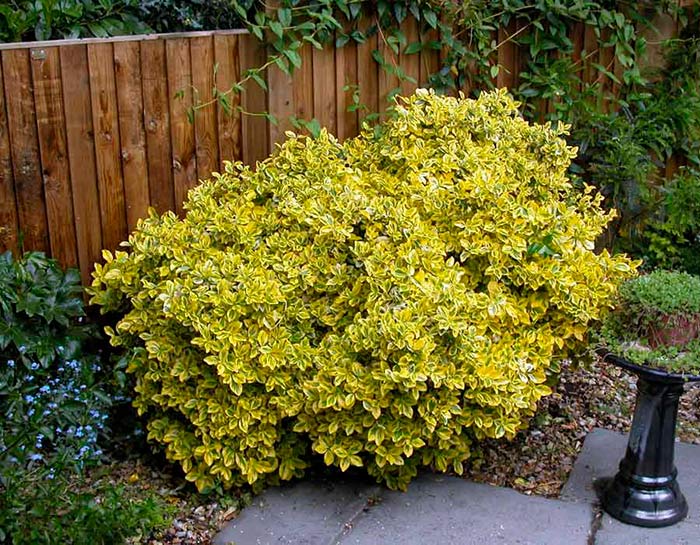

Several times during the season, euonymus can be fed
Fertilization frequency - 2 times a season. In the spring, in April-May, compost and mineral complex are usually applied. In autumn - mixtures with potassium and phosphorus. Humus and compost also work well as fertilizer for shallow digging in the first months of a young bush's growth.
Diseases and pests
Fortune has good immunity to various garden diseases, and proper care and preventive treatment can protect the plant from many troubles. Therefore, in the spring, the bushes need to be treated with special fungicidal preparations. But if, nevertheless, the plant is weakened and sick, then most often it is affected by fungal diseases, among them the most common is powdery mildew. Its signs are a characteristic gray-white bloom on the leaves, which soon dry up and fall off. The diseased bush must be treated with Bordeaux liquid or other fungicides.
Among the pests, the most annoying bush is spider mites, moths, scale insects, aphids. They fight them with insecticidal preparations.
If you are thinking about how unusual to decorate your site and so that it, moreover, does not require careful maintenance, then you will be interested to learn about such as In this article, we will consider its detailed description, talk about popular varieties of this plant, planting and care behind him.
Shrub care: features
In the open field, the plant is undemanding to attention. Caring for him can be reduced to performing simple manipulations:
- Watering the shrub is needed only when the topsoil is dry. If it rains at least once every 2 weeks in summer, you don't have to worry about watering at all.
- Mulch will help retain moisture. Use pine sawdust.
- Pruning will help you shape the bush into what you want. You can even make a standard type plant.
- Shrubs need regular loosening and weeding immediately after planting. Weeds can harm young seedlings. Loosening is best done 3-4 days after irrigation.
Advice. For the winter, annual shrubs of some varieties should be covered. Gardeners make a mound of dry leaves up to 20 cm in height. Ideal conditions and care in frost for euonymus are natural snow cover in a windless area.
Short description
This plant is native to China
and is a dwarf shrub reaching 30 cm. It spreads on the ground, rooted well and has bright green oval leaves with a yellow or white border, which become pink or darker in autumn. If you put a support next to it, then its shoots will begin to curl along it, but basically this plant is used as a shrub creeping along the ground. In temperate latitudes, it practically does not bloom. However, Fortune's euonymus is appreciated not for its flowers, but for its variegated leaves, which will be a great addition to any composition in landscape design.
Did you know?
The plant was named after the botanist Robert Fortune, originally from England. He was the first to notice and describe this shrub while in China.
Evergreen euonymus: cultivation, varieties
Euonymus (Euonymus) belong to the family of Euonymus (Celastraceae). This vast genus includes more than 120 species distributed in Europe, Asia, Australia and America. In nature, euonymus grow in valleys and floodplains of rivers, as well as in the undergrowth of mixed forests.Shrubs begin to bloom in late spring, simultaneously with the blooming of leaves. Small, completely inconspicuous flowers are yellow, greenish-white, cream and maroon. They smell unpleasant and are pollinated by insects. The euonymus has unusual poisonous fruits with bright seedlings. The leaf arrangement is opposite.
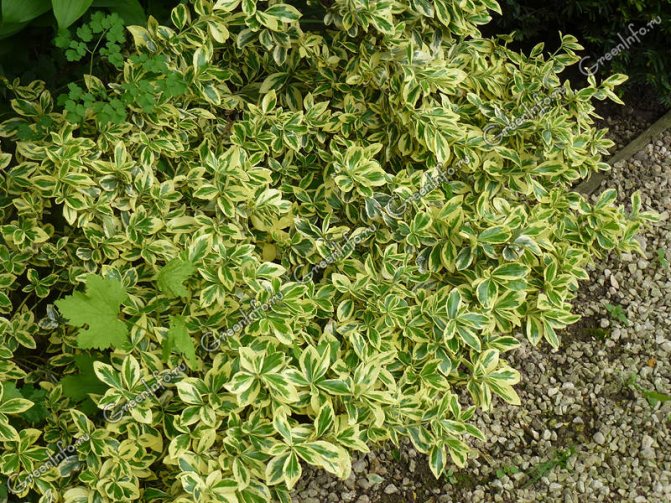

Fortune's spindle tree Canadale Gold
In addition to deciduous tall euonymus, low evergreen shrubs are known, which are characterized by weaker winter hardiness. Many graceful species of this group are suitable for planting among stones in rockeries and rock gardens.
Dwarf euonymus (Euonymus nana) naturally grows from Europe to Western China, including the mountainous regions of Western Ukraine, Moldova, Crimea, the Caucasus and Mongolia. It is an evergreen shrub about 30 m high with narrow leathery leaves 3-4 cm long. Shoots are green and greenish-gray, with longitudinal grooves. The flowers are small, 5-7 mm in diameter, with 4 greenish-brown petals, appear in June. In autumn, pink 4-lobed pear-shaped bolls are formed, however, in our strip, the shrub rarely bears fruit.
| Dwarf spindle tree in Kiev | Dwarf spindle tree, fruits |
In culture, the species has been known since 1830. It is planted under a thin canopy of trees in small groups, used for landscaping in England. Although it is thermophilic, it is preserved in the old parks of the Moscow region, growing by rooting creeping shoots and escaping under the snow in winter.
The Koopmann euonymus (Euonymus koopmannii) is very similar to the dwarf euonymus, its height is no more than 1 m. This species occurs in the mountainous regions of Central Asia (Tien Shan and Pamir-Altai). Shoots are the same, green, ribbed, mostly lodging and spreading by rooting. Ascending shoots with narrow-lanceolate or linear-lanceolate leaves 1.5-5 cm long. Leaves above are shiny, leathery, glaucous below. Greenish flowers about 5 mm in diameter sit singly or are collected in half-umbels of 2-3 pieces. Four-lobed bolls are not formed in our zone. In culture, the species has been known since 1883, it is used in America, England and Germany, in Russia it is very little widespread.
Japanese spindle tree (Euonymus japonica) comes from China and Japan, where the height of an evergreen shrub reaches 6-8 m. Greenish-brown shoots are tetrahedral in cross-section. The leaves are obovate, 2-7 cm long, with a rounded top and a wedge-shaped base. Greenish-white flowers with a diameter of 5-8 mm with 4 petals, collected in umbellate inflorescences. Fruits are four-nested capsules with pink orange seedlings, but in our conditions they are not always tied.
The species has been cultivated since 1804. Ornamental-deciduous forms are known:
| B. Japanese Aureo-Variegata in St. Petersburg | Japanese spindle tree Albo-Marginata |
- Aureo-Variegata (Aureo-Variegata) with yellow-spotted leaves;
- Argenteo-Variegata (Argenteo-Variegata) with white-spotted leaves;
- Albo-Marginata (Albo-Marginata) with white edging on the leaves;
- Aureo-Marginata (Aureo-Marginata) with golden edging of leaves;
- Macrophylla (Macrophylla) with larger leaves up to 7 cm long;
- Compacta (Compact) has a compact crown and small size;
- Pyramidata (Pyramidata) with a pyramidal form of growth and wide-elliptical leaves.
Due to the low winter hardiness in Central Russia, it can only survive under snow, therefore it grows as a low-growing shrub about 1 m high.Conditions are more favorable for it in the south of Russia, in the Crimea, in the Caucasus, in Moldova, in the southern regions of Belarus and Ukraine.
Fortune's spindle tree (Euonymus fortunei) is native to China. It is closely related to the Japanese euonymus. It is a small evergreen shrub 20-40 cm high with creeping shoots covered with elliptical or oblong-ovoid dense shiny leaves.The appearance of small greenish flowers in Moscow is noted occasionally, and practically no fruiting occurs.
The species has been known in culture since 1907. Among evergreen euonymus, its variegated varieties are most often brought to Russia from European nurseries. The following are especially popular:
| Fortune's euonymus Emerald Gaiety | Fortune's spindle tree Canadale Gold |
- Emerald Gaiety (Emerald Gaiety) - a variety with an uneven white border on dark green leaves;
- Canadale Gold (Kanadale Gold) - a compact bush with shiny yellow-crushed leaves;
- Silver Queen (Silver Queen) - compact variety with creamy young leaves, mature leaves with a wide creamy stripe along the edge, in some years flowering was noted;
| B. Fortune Emerald'n Gold in the UK |
- Eonymus Fortune Sunspot in Kiev
Emerald'n Gold (Emerald Gold) - a bush 40 cm high, elliptical leaves up to 3 cm long, their middle is marbled or gray-green, and along the edge there is a light yellow or lemon-yellow border 2-4 cm wide, in spring the leaves are yellow , and become bright pink in the fall;
- Blondy - variegated variety, bush 40-50 cm high, in the middle of the leaf there is a large yellowish-white spot, in autumn the leaves are pink-red;
- Sunspot (Sunspot) - in the middle of the elliptical leathery leaves, an uneven wide yellow stripe, the edges of the leaves are dark green;
- Harlequin (Harlequin) - a new variety with large white spots on the leaves;
- Vegetus (Vegetus) - a profusely flowering variety with powerful shoots and large leaves, all young leaves and shoots are white.
- Kewensis (Kevensis) - graceful variety with small dark green leaves;
- Dart's Blanket (Darts Blanket) - a variety in which dark green leaves turn bronze by autumn;
- Coloratus (Coloratus) with bright green leaves in spring and summer, and purple in autumn.
Eonymus Fortune Coloratus
But, unfortunately, many of these varieties do not bloom and do not tolerate the climate of Central Russia well.
Popular varieties
The euonymus family has many different varieties, no less than 120. But we will not consider all types, but only imagine the most popular ones.
- The first variety on this list
In appearance, it is similar to euonymus growing in its natural environment. The leaves are matte, elliptical, dark green in color, reaching a length of 40 mm. The veins and edging of the leaves are white. This species grows up to 15 cm in height. In the case of suitable conditions, it grows very well, forming dense carpets. If you live in a region with very cold winters, then the Fortune euonymus of this variety is just for you, as it has excellent winter hardiness.
From the name it is clear that this variety is more miniature, but it also creates a lush coverage. The leaves are elliptical and reach 1 cm in length. By the way, this variety is also frost-resistant.
Translated from English it means "emerald in gold" and this name perfectly describes its appearance, because it is because of it that this variety is very popular. The leaves have a rich emerald color, and the edging is bright yellow, as if the leaves were really dipped in gold. As soon as autumn comes, the leaves take on a deep red, wine tint. It reaches a height of 30 cm, and the leaves are 2 cm in length. This variety will not suffer in frosts down to -25, even in the absence of snow.
This variety does not particularly grow in width, but reaches a height of 20 cm. The leaves are in the form of an oval, having a white border of 2 centimeters long. The Fortune euonymus of the Emerald Haiti variety can withstand frosts down to -25 ° C.
It is a compact, not fast-growing and not very prolific shrub, with oblong-oval leaves 2 cm long and 20 centimeters high. It is also called a sunbeam for its bright yellow speck in the middle of the leaf. The cold season for this variety does not pose a mortal danger.
Tall bush, reaching 35 cm in length and width. It does not grow very much. It has large oval leaves 4 cm long. Its peculiarity is the fact that young leaves first have a yellowish-green color, and then darken to green. Resistance to cold temperatures is average.
Varietal variety of shrubs
The efforts of the breeders were not in vain, so now you can pick up many variants of this variety for planting.Let's consider the most popular ones:
- Fortune's euonymus Emerald'n Gold... Low bush - up to 0.6 meters. It differs in leaves with a golden frame, by autumn they turn into a bright pink color. For the winter, the bush does not require shelter.
- Vegetus... The bush is notable for its miniature forms - up to 0.15 meters. Leaves of a rich green shade with veins of white, in our regions it can winter without shelter, but in severe winters it is better to insulate the plant with spruce branches.
- Canadale Gold... The leaves have a yellow border, the bushes are compact, rapid in development, reaching up to 0.6-0.8 meters in width.
- Eonymus Fortune Harlequin... A dwarf variety with variegated white leaves, pink, cream and yellow blotches. It is considered an excellent ground cover for growing in shaded areas. The height of the culture is up to 1.4 meters, the width is 100 cm.
If you are thinking about what unusual plant to decorate your site with and so that it, moreover, does not require careful care, then you will be interested to learn about such a shrub as Fortune's eonymus. In this article, we will consider its detailed description, talk about the popular varieties of this plant, planting and caring for it.
Application in landscape design
grows very well.
And thanks to this property, it is used as a ground cover shrub.
It is very rarely planted singly, usually it can be seen in large tracts, a variety of ribbons and dense groups.
Since euonymus does not require anxious care, it can often be seen in the city in parks, squares, near monuments, shops, office buildings, and so on.
Very nice Fortune's euonymus
looks in tandem with different for example
Gardeners on their plots use for a variety of compositions, rocky gardens, alpine hills, flat rockeries. It is planted together with perennial shrubs near their foot, for example near others.
The variety is used as a lawn as it forms evergreen carpets. The baby is used for stone compositions: and rocky mixborders, planted with ribbons along the perimeter of the paths.
Also variously used euonymus Fortune varieties Emerald Gold
as various mixed compositions, large arrays, rocky gardens and so on.
The variety will perfectly complement the composition of any style, both Japanese and ordinary rural.
Seat selection
When choosing a planting site, keep in mind that almost all varieties prefer a lot of light and sun.
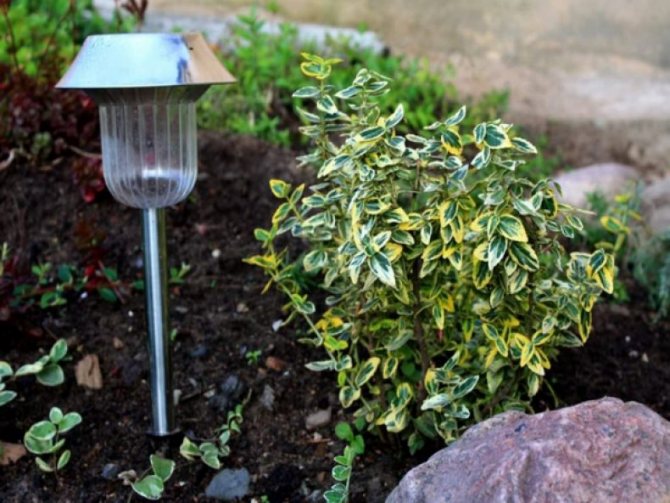

Therefore, it will be better if the rays hit the plant in the morning or in the evening. Also, the proximity to underground waters is not suitable for euonymus, so it must be planted on a hill.
Next, turn on your imagination. You can decorate your plot with it, planting it along the paths, in the garden composition, on the alpine slides or next to the gazebos.
Step-by-step planting process
The best time to plant is in the springtime of the year, namely April or May. The plant will take root well during this time and will be ready for cold weather. You can plant euonymus in the fall, but in this case the chances of successful cultivation drop several times.
So let's move on to a step-by-step description of planting a plant:
- Depending on the composition, we dig a hole or trench.
- The pit should be one and a half or two times larger than the root with the soil that covered it.
- At the bottom, it is imperative to lay a layer of 15 cm. This must be done in order to protect the plant from groundwater. For these purposes, expanded clay, broken brick or gravel are suitable.
- We make a soil mixture from the excavated soil using peat, sand, humus and mineral fertilizers.
- We plant the plant at a shallow depth. The root collar should not be deeply deepened into the soil.
- Then the hole needs to be filled up and the earth compacted around the planted spindle tree, forming a hole.
- Water the plant well.
- After watering, it must be used to maintain soil moisture. For these purposes, you can take peat, or fallen leaves.
In order for the plant to grow as it should be, it should be provided with full and proper care. Let's find out what you need to do for this.
Watering
Fortune's eonymus is pretty drought-resistant plant.
But after planting it must be watered regularly so that it can safely take root in a new place. This should be done once a week. If there is little rainfall, then it is better to increase the number of irrigations up to twice a week. Already mature bushes can be watered less often, as the ground around the plant is completely dry. However, spring is an exception to the rule, at this time the euonymus needs to be watered more often, since the winter time takes a lot of energy from the plant.
Top dressing
In the first year after planting, the euonymus does not need additional feeding, because the soil still contains the substances it needs. Then you can feed the plant both in spring and autumn.
After winter, they are used for these purposes, and before the onset of cold weather - or
Pruning
Fortune's euonymus grows rather slowly, so it does not need formative pruning. Sanitary pruning can be done in early spring. During it, you need to remove all dried, damaged and broken branches of the plant with the help of a pruner. The only thing that can still be said is that branches that are too long, breaking the shape, need to be removed, as they spoil the appearance of the shrub.
Wintering
As you have already noticed, Fortune's euonymus is different excellent cold resistance.
Still, newly planted plants are not yet so strong and need to be covered for the winter. For this, burlap or fallen leaves are suitable. Adult shrubs can no longer be insulated, but you should pay attention to the variety that you planted and your climate. Perhaps the plant will not interfere with additional protection.
Important!
If your euonymus bushes do bloom and bear fruit, then you can see how birds are feasting on them. However, you should not do this, since for a person its fruits are poisonous.
Fortune's euonymus: combination with other plants
This culture is versatile in the garden. Depending on the variety and method of pruning, Euonymus can decorate a rocky landscape, a border, a flower bed or a parterre. Where winters are not too frosty, the plant becomes a vine on the wall of the house in the manner of ivy. Gardeners often choose a suitable variety simply from a photo that reflects the color scheme of the plant.
Euonymus is suitable for combination with almost all inhabitants of flower beds. For example, in topiary, mixborders. In the open field, combinations with conifers and other ornamental shrubs are used. The crop is also successfully grown in street containers.
Fortune's euonymus will help you quickly and brightly plant greenery on your site. Growing and caring for this plant is simple, and the options for using its decorative properties are extensive. For this culture and fell in love in many countries.
How to deal with possible diseases and pests
To prevent plant treatment and extermination from various, it is necessary to know the enemy by sight and take preventive measures in time. To do this, you should process the shrub in the spring season. And the correct watering and placement of the plant in a sunny place will protect it from a variety of pests and fungal diseases.
But nevertheless, if for some reason these measures could not be carried out, the pests that the euonymus may encounter are also presented below:
Did you know?
Fortune's euonymus is successfully used in folk medicine, despite the fact that it is poisonous. Fruits, leaves and wood contain many beneficial substances such as vitamin C, fatty acids, tannins, and so on. Decoctions and infusions have antiviral, antiemetic and choleretic effect.
Site preparation
After you have decided on the location, you need to prepare the selected area for planting. Fortune's spindle tree is unpretentious to the soil, however, there are small nuances. It is better to plant it in loose and light soil. If you want a beautiful healthy bush to grow, then you need to make a fertile soil mixture from peat, sand, turf, humus and wood ash. The addition of mineral fertilizers will not hurt either.


Propagation using cuttings
Special efforts for Fortune's euonymus will not be needed even during its reproduction, it is enough to follow simple instructions. In June or July, the tops of semi-lignified shoots are cut off from a bush at least 5 years old, these are cuttings. They should be about 7 cm long and have one internode. The cut of the cutting must be treated with a root former, planted in a mixture of peat and sand and kept under a film in a cool, well-lit place. After two months, the cuttings take root and should already be planted in open ground. Then grow in accordance with all the rules for caring for this shrub.
Fortune's spindle tree looks like a small evergreen shrub that creeps along the ground. Green leaves have a bright yellow border. While this plant is rarely found in an amateur garden or at a summer cottage. Basically, Fortune's euonymus is used to embody various ideas in landscape design. It is appreciated for its beautiful bright leaves.
Description and photo of Fortune's eonymus
There are more than 120 species of shrubs in the euonymus family, which are widespread in Asia, Europe, America. In central Russia, unfortunately, this species practically does not bloom.
Fortune's euonymus Emerald and Gold is one of Fortune's varieties, the translation of which from English means “emerald in gold”. This name is associated with its color of foliage. All leaves are bright green with yellow edging. With the onset of autumn, the leaves change color from yellow-green to red-brown. This variety of Beresklet grows compactly and usually grows poorly. In central Russia, a shrub can survive the winter only by hiding under a layer of snow or a special covering.
The very compact bush of Fortune's euonymus Emerald Gaiety has a bright green color of leaves with a white border in the summer, and by winter its color changes to pink. This type of shrub is suitable for life in more severe conditions as it is resistant to frost and can withstand temperatures down to -25 degrees.
Fortune's eonymus, photo in landscape design
Planting and caring for Fortune's Euonymus
Landing features:
- Usually spindle trees are planted in spring or autumn.
- The earth must be well dug up and loosened.
- The seedling is planted in a hole dug 2 times the size of the seedling earthen lump.
- Compost is added to the pit and mixed with the ground.
- A shrub is planted in the ground at the same depth at which it lived in a pot; after planting, the ground should be compacted and a circle for irrigation should be formed.
- To feed the soil around the shrub, it is necessary to periodically add mulch from crushed bark and compost there. In addition to nutrition, mulch removes weeds from the soil and helps retain moisture.
- The most favorable time for planting the Euonymus is the end of April or the beginning of May.
Shrub care features:
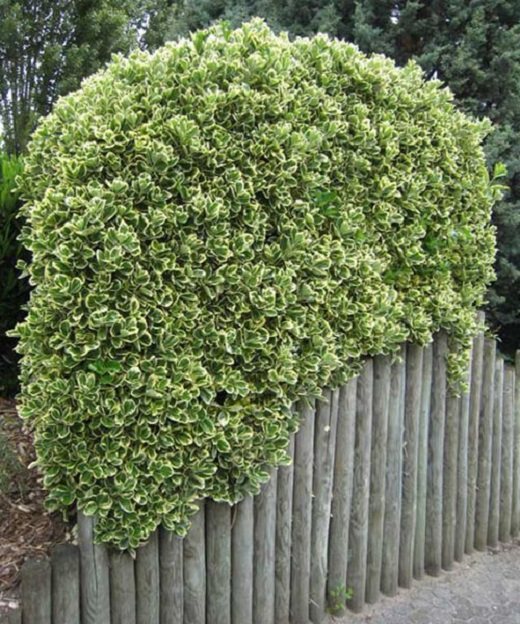

Shrub pests:
Absolutely all plants are susceptible to insect attacks and the euonymus shrub is no exception.
- When a bush is damaged by insects, chemical treatment is carried out, the best time for this is the spring months of April and May, it is possible in June. If only some of the branches are affected, you only need to prune them.
- The appearance of silvery dots on the leaves of the bush means that the plant has been attacked by a spider mite. He is afraid of moisture, respectively, the shrub must be watered more often.
- The appearance of powdery mildew on the leaves means that the shrub is infected with a fungus.Dew appears as a white or gray-brown bloom on the leaves. As a result, the leaves may turn yellow, in a more neglected and severe form, plants die. This disease is difficult to control, so it is immediately necessary to take preventive measures.
- Every spring, it is advisable to treat the bushes with antifungal drugs specifically for prevention.
- Top watering of the plant is undesirable.
- It is important that the shrub is planted in a place well-lit by the sun, this also has a positive effect on the plant, and is also of great importance as a prophylaxis against diseases.
Plant propagation: options
Cultivation of euonymus in the middle lane rarely ends with flowering and seed formation. For reproduction, gardeners use simpler and more effective methods:
- Cuttings. Pick an adult plant that is at least 5 years old. At the end of June, cut the shoots into cuttings 6-8 cm long with at least one internode. Plant directly under the foil, in nutritious and loose soil. Pour a layer of sand about 3 cm on top of the soil. With proper care, the cuttings will take about 1.5 months to root. After that, he immediately needs a landing in open ground.
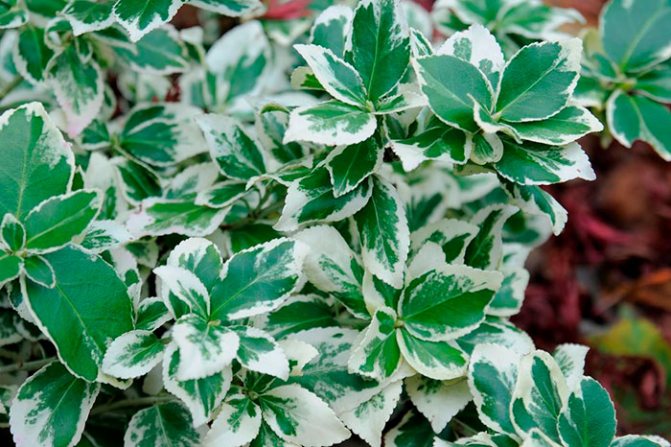

A plant older than 5 years is suitable for propagation by cuttings.
- Root offspring. Planting material should be cut off before the plant awakens, in the first thaw of spring. The length of the shoot is 40-50 cm. The length of the root is 20-30 cm, the thickness is not more than 1.5 cm. An earthen lump should remain on the root. The shoots can be planted directly on the garden bed or grown into a full-fledged seedling.
- Shrub division. A good breeding method for dwarf varieties. The plant itself forms young shoots on the main rhizome. It is important to separate it carefully. Cut the divisions 2/3 before planting.
Subtleties of care
It is not difficult to care for Fortune's spindle tree, although some rules and recommendations must be followed. By giving the culture minimal attention, care and maintenance, in a short time it will be possible to enjoy its lush foliage and extraordinary coloring.
Careful watering is an important step in the care. And although euonymus belongs to drought-resistant species, at a young age it needs to be watered regularly, which will have a good effect on survival in new conditions. The optimal frequency of watering is once a week, while in a dry period it is increased up to two times. As for the more mature representatives of the variety, they are watered twice a month.
Also, the gardener needs to loosen and mulch the soil, regularly feed, pruning and arranging the protection of the bush from the cold.
Performing such actions will be the key to productive growth and development of an incredibly beautiful evergreen shrub.
nasotke.pro
Fortune's eonymus (Euonymus fortunei), sometimes called euonymus rooting (E.radicans), grows wild in China, where, by the way, more than one third of the total number (up to 220 species) of trees and shrubs of the genus euonymus comes from. It belongs to a large (about 70 species) community of evergreen spindle trees and has a reputation as the most frost-hardy of them. By the way, I will tell you about the frost resistance of this euonymus. In my garden, I tested more than 6 varieties and forms, and none of them, even in the most severe winters, was under the threat of freezing, although a cold winter with no snow is a very tough test for many plants. I never cover plants, but I pay great attention to the planting site, the composition of the soil, the presence of drainage. In our conditions, these are the decisive factors for the successful wintering of even more frost-resistant crops.
In nature, Forchuna's euonymus is a creeping shrub up to 30-60 cm high, with thin shoots up to 3 m long. Spreading to the sides and bumping into obstacles, the lashes of the plant can slightly climb on them, clinging to the adventitious roots.On a flat surface, when touching the ground, spindle tree shoots easily root and form a dense cover that completely covers the ground. The leaves of the plant are ovoid, slightly corbate along the edge, 2-6 cm long, located opposite. The surface of the leaf is leathery, shiny. The flowers of this euonymus are rather inconspicuous, and in our conditions the plants bloom extremely rarely.
In Europe, Fortune's euonymus has long and firmly occupied the niche of an all-season ground cover shrub. In France, England, Holland and other countries where the temperature does not drop below -5 C in winter, Fortune's euonymus is often used as a vine for decorating walls, retaining walls, etc. In this case, the plants are helped to attach by tying or otherwise.
The modern European assortment includes several dozen varieties of Fortune euonymus. These are both green-leaved plants and cultivars with variegated leaves. This is not to say that these varieties are famous for a wide variety of colors. Looking closely, you will notice mainly three colors: green, yellow and white. But their combination and the shape of spots: in the form of a border, speck, stripes, etc. create an impression of diversity. All varieties, to one degree or another, retain the property of the main species to creep to the sides. But this quality also varies over the widest range.
Pests
Shrub owners should be prepared for the appearance of spindle tree pests:
- If the plant is attacked by a spider mite, silvery dots appear on it. To get rid of it, the plant needs to be watered more often. This insect is afraid of moisture.
- Powdery mildew and fungus are common on the euonymus. A gray-brown or white bloom appears on the affected plant. If you do not take any action for a long time, the leaves will dry out and the plant may die. To prevent this from happening, the plant is sprayed with antifungal drugs in the spring.
If several branches of the plant are damaged, they are carefully pruned. It is better to treat shrubs with chemicals in April or May.
Never use overhead watering for plants. And so that the shrub does not get sick, it is better to choose well-lit places for planting.
Growing by seeds
As already mentioned, vegetative breeding methods are considered the simplest, most affordable and productive. In most cases, they give excellent results, allowing the grower to enjoy a healthy and vigorous plant in a short period of time.
However, in addition to these techniques, euonymus can be grown by seed. Naturally, such an action takes a lot of time and effort, and when propagated by seeds, it is impossible to preserve the decorative properties of the mother bush, which is also a minus.
Immediately before planting, the selected material lends itself to stratification in a manganese solution. After such treatment, the seeds are placed in a container with wet sand, where they are kept for at least three months, as a rule, all winter.
Then the stratified seeds need to be transferred to a warm room for 3-4 months, which is quite enough for their full germination. Planting material is sown into peat or sand, leaving it there for about 30 days. During this period of time, the first green seedlings should appear from the ground. Basically, the seed method takes about 3-4 years, while the probability of seeds rooting, unfortunately, is minimal.
Barberry Thunberg: description of varieties and features of care
Indoor variety of euonymus
The shape of the indoor euonymus deserves special attention. Indoor plants are a special form of euonymus. Of the wide variety of euonymus, only two species are kept at home: rooting and Japanese.
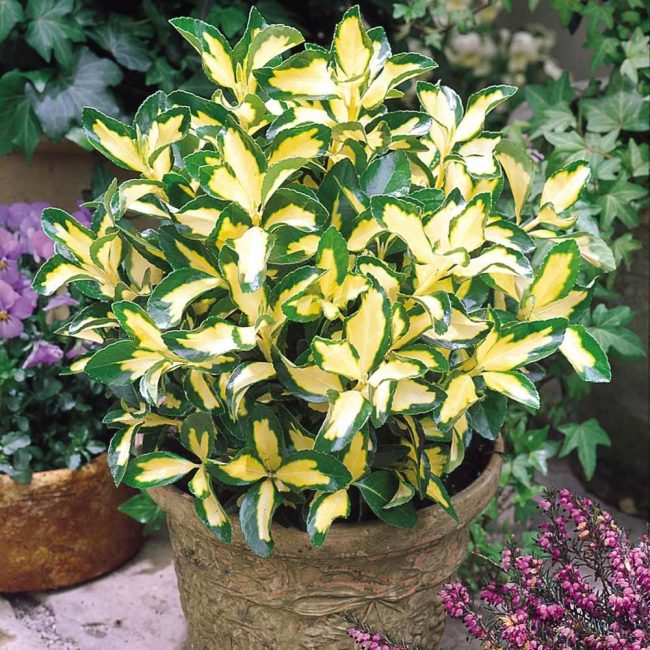

Of the indoor species, Japanese euonymus is the most popular.
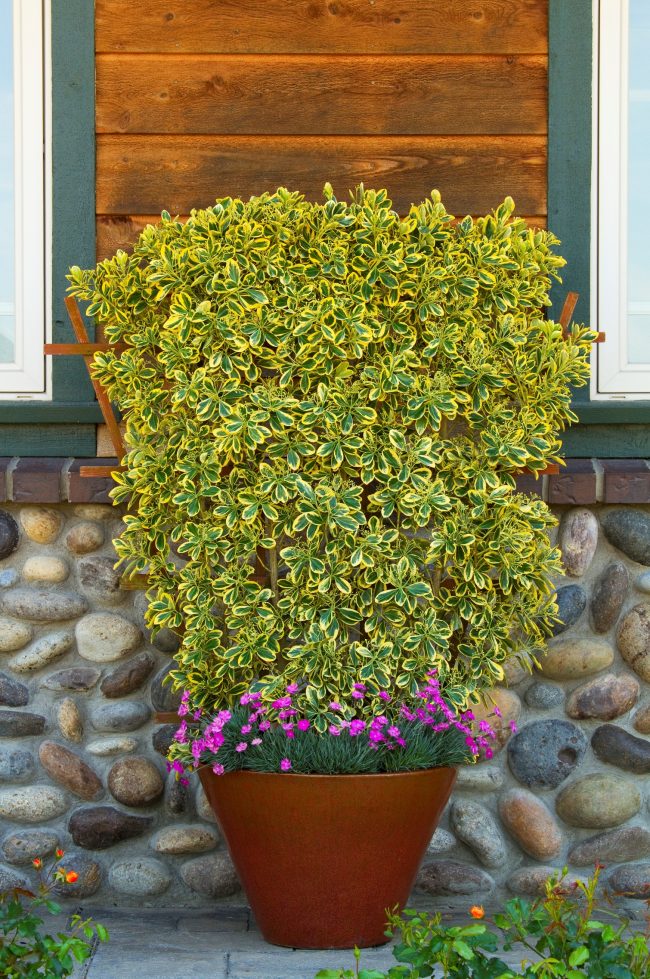

Indoor variety of euonymus
If we talk about options for indoor content, then they can be curly or in the form of a tree.The leaves on the plant can be variegated or green. Small flowers are collected in white inflorescences. To ensure a good existence for an indoor flower, it is necessary to create certain conditions for its cultivation.
Consider an indoor euonymus, its planting and care (see photo below).
The main conditions for the full development of the spindle tree:
- The location of the plant. To provide good vegetation, you need a lighted place, you can place the euonymus on the window in direct sunlight. However, he feels good in partial shade. Alternatively, for the summer, you can place the plant on the street: balcony, loggia, in the garden. For the winter, he is brought into the room.
- Temperature conditions. A feature of the plant is its unpretentiousness to the temperature regime: it can grow at + 5-10 ° C. If it is too hot in the room in winter, it may begin to shed foliage.
- Organization of watering. Indoor euonymus does not require a lot of moisture to care for. Especially in the winter period, it is extremely rare to water it, preventing the land from drying out. In summer, you can increase the amount of water. Loves spraying.
- Priming. An excellent composition of the mixture for growing a plant is the use of woody humus and earth. You can add sand, peat and turf soil.
- Transfer. A young plant must be replanted every year, an adult one every 3-4 years in the spring.
- Fertilizer. Euonymus needs fertilizing, organic fertilizers in the spring and autumn, in winter this should not be done.
- Pruning. In order to create a beautiful shape, you will need to regularly trim the euonymus. Weak shoots should also be removed from time to time. By pruning the plant, you can create crown shapes such as a ball, cone, ellipse, or a bonsai tree.
- Disease control. A characteristic disease of this plant species is gray rot. It is most often provoked by excessive air humidity. You can deal with this by draining the room and using special antiseptic solutions.
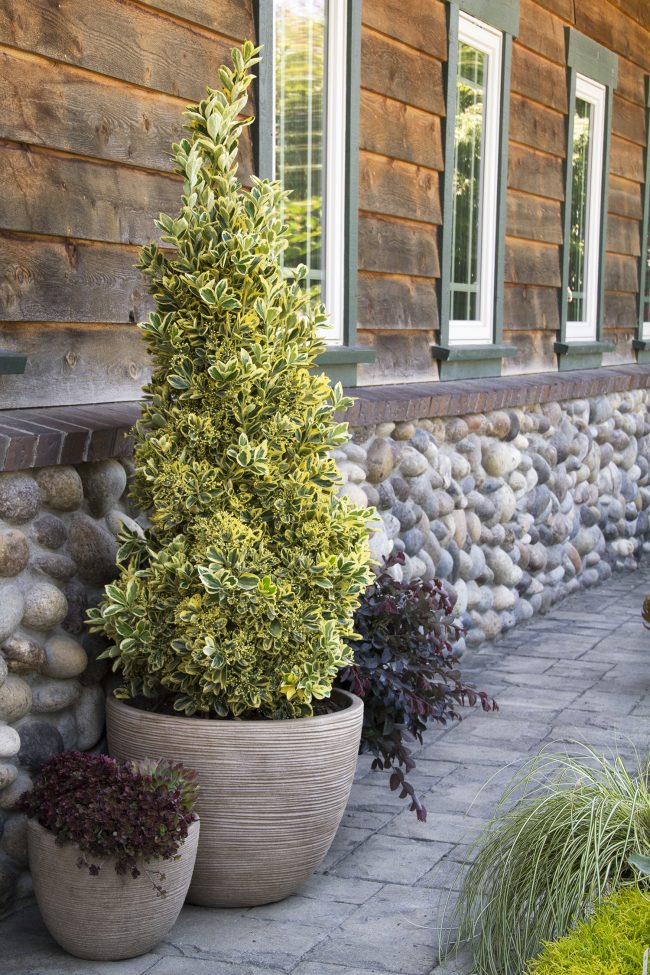

Euonymus loves good lighting and moderate watering.
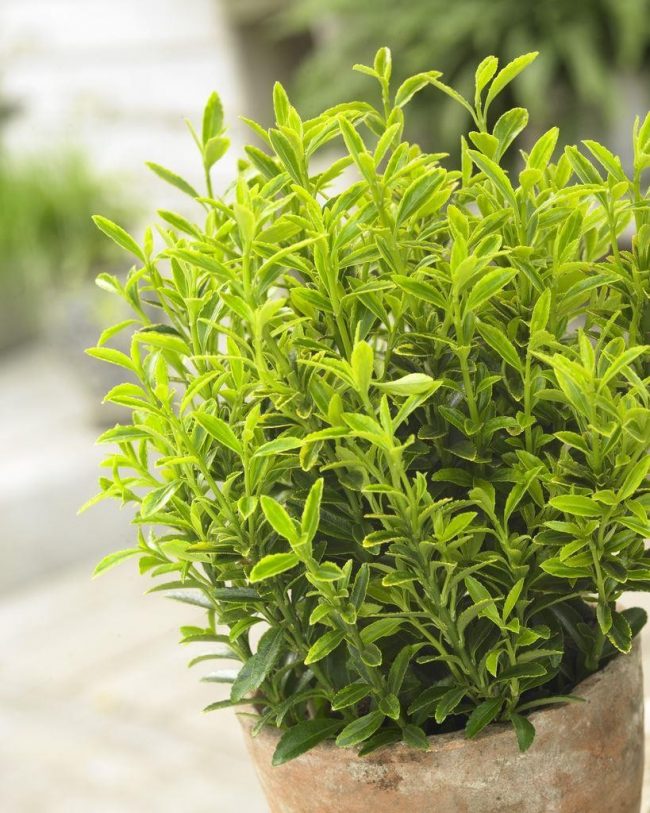

With the right care, your plant will be bushy and brightly colored.
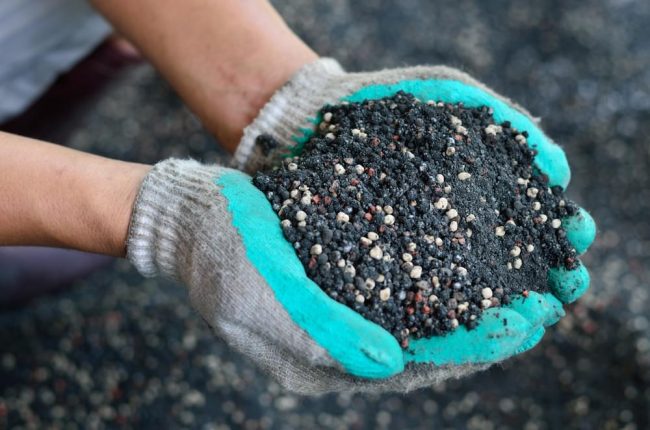

Particular attention should be paid to the selection of special soil
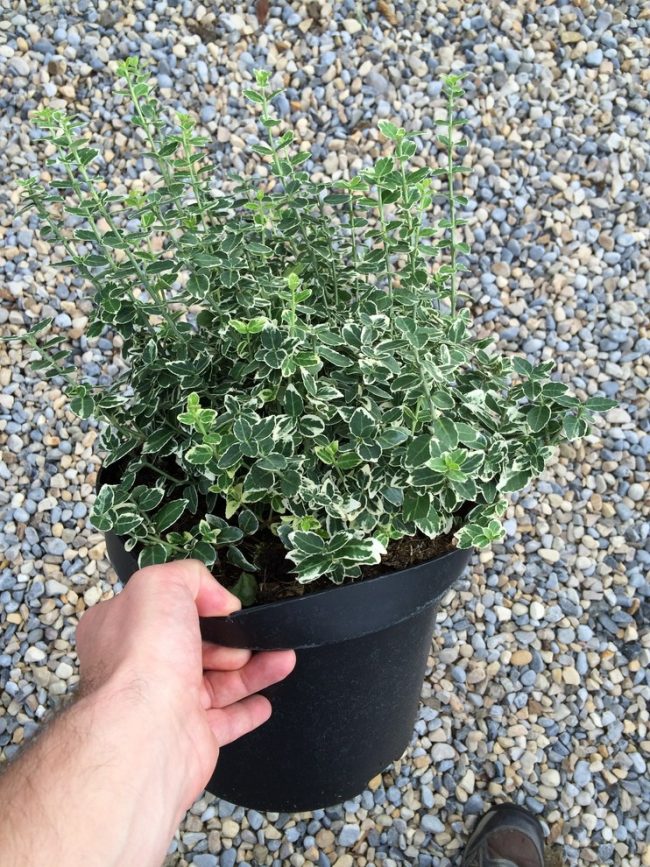

Indoor species of spindle tree also need pruning.
How to Grow a Lonely Tree in a Potted Culture
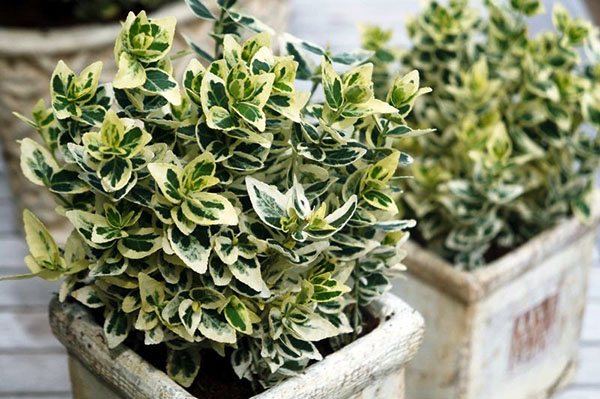

Like any young, rapidly developing plant, euonymus is planted in a small container, in light soil. First, they are transplanted every year, then less often. In the summer, the culture is kept outdoors, in the winter, it is arranged in a cool room with a temperature above 5 degrees.
In a warm room, the plant also overwinters, but it can shed its foliage. Keeping a plant indoors is not easy. Leaves are lost from heat, moldy from moisture, turn pale in the shade.
Adapted for cultivation as a houseplant Japanese euonymus. Its leathery blue-green leaves are more resistant. During growth, the young tree is deformed, creating bizarre branches.
Spindle tree in the garden - video
Features of the view
Fortune spindle tree (or euonymus fortunei) is native to China. This creeping shrub can reach up to half a meter in height and 3 meters in length. In this case, the branches form knotty plexuses that grow into the ground. Thus, the shrub spreads over the surface and trees. Due to the fact that the leaves, most often having a two-color color, grow close to each other, a very dense and dense crown is created.
The leaf shape is slightly oblong, 2-6 cm in length. The color of the inflorescences is nondescript, pale green. An exotic plant has fruits in the form of four separate capsules, but they cannot be eaten, as you can get poisoned. It is these fruits that attract attention.
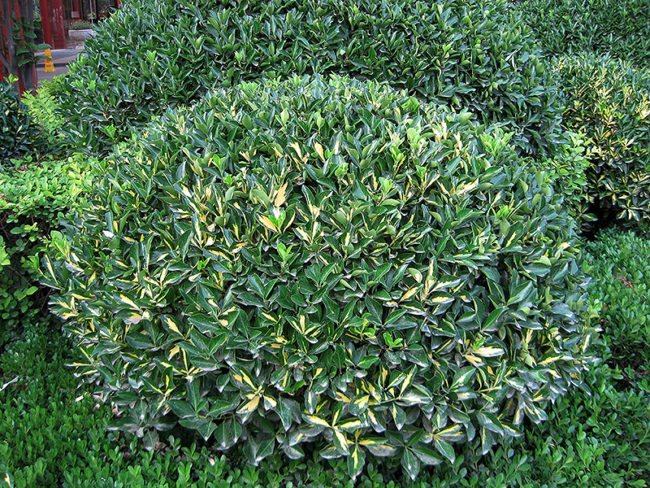

At the very beginning of development, they are greenish, but as they mature, they change their shade from pale pink to bright purple. This usually happens in the fall, when most of the other flowers have already faded.Due to the fact that numerous shoots are covered with snow, the shrub easily survives severe frosts at -25 degrees Celsius.
Home care
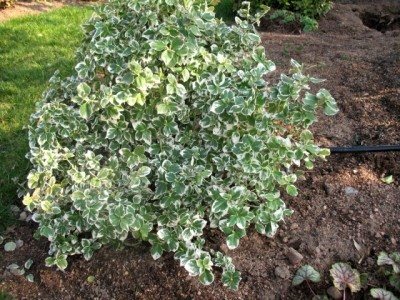

The shrub is considered resistant to external environmental factors, but it needs proper care to reveal its potential.
Due to its slow growth and year-round decorativeness, it can be kept both in open and protected ground.
At the same time, the ways of leaving each other are nothing different, and consist of several techniques and rules.
Post-purchase actions
Fortune's eonymus is purchased in a pot. When buying it, you need to carefully consider the presence of pests and diseases.
Further, the shrub is planted in a permanent place. Planting rules are no different from transplanting, but after that the plant is not fed during watering until the root system takes root.
Pruning
The shrub grows very quickly. To form the necessary shape, it is periodically trimmed. As such, formative pruning is unnecessary, but an aesthetic form is achieved by removing dead and protruding branches.
Watering
"Euonymus" is characterized by drought resistance, and does not tolerate stagnant moisture. You need to water the plant according to the principle - it is better to water less than to fill it "in reserve".
But the watering of young plants must be monitored, and this should be done more often due to the weaker root system.
Reference! In the summer, the shrubs do not need high humidity, but in the greenhouse they need periodic spraying.
In winter, in conditions of closed ground and low temperatures, watering is reduced, and in summer they make sure that the soil in the container does not dry out.
Transfer
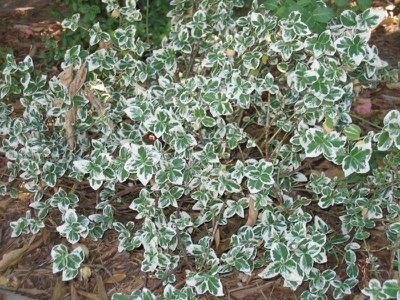

The shrub is transplanted in spring or autumn. For this, a hole is prepared, which is twice the earthen lump on the roots.
The soil extracted from the hole is mixed with well-rotted compost.
Removing a seedling from a pot or a previous place is done carefully, and planting is done at the same depth as before.
After planting, the soil is compacted.
Growing
Adult shrubs are watered up to four times during the season, while young ones are often more abundant, especially during dry periods. The compacted soil is loosened and regular mulching with peat soil mixture is carried out to a depth of 6 cm.
For the winter, young plants (up to 2 years old) are covered with dry leaves, and it is not necessary to cover older ones. Digging is carried out in the fall, under which slaked lime is added.
Reproduction
The easiest way is to propagate "Beresclet" by rooted shoots. If you press a branch to the ground, it releases roots in this place.
After a certain time, it is cut off and transplanted to a new place. To make the process faster, the pressed shoot is sprinkled with soil a little.
Another method of vegetative propagation is cuttings. To do this, not young shoots are selected and cut off with a pruner at an angle of 45 ° up to 12 cm long. The cuttings are planted in a moist soil mixture, and for better survival, a rooting agent is used.
Reproduction of euonymus by seeds is possible. For this, in the first half of spring, sowing is carried out in the beds to a depth of 2 cm in a special substrate.
It is prepared by mixing one part of sod land, two parts of humus and one sand. The emergence of seedlings occurs on average after 20 days.
Indoors, sowing is carried out at the end of January, while by the end of summer you can get stronger seedlings that give natural growth.
Temperature
The plant prefers a moderate temperature, in summer up to 25 ° С, and in winter about 8 ° С, but not higher than 12. It does not tolerate severe frosts well, but too strong heat affects the plant negatively.
Important! In winter, the temperature inside the room where the euonymus is located should be no higher than 16 ° C. If it rises more than + 20 ° C, the shrub sheds its leaves.
Lighting
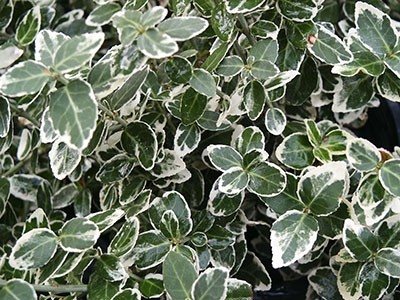

The plant loves direct sunlight, under the influence of which the leaves acquire a bright spotted pattern.
But it is better that the direct exposure to the sun occurs in the morning or in the evening.
Guided by this rule, you need to choose a suitable place to place the euonymus.
The lack of light is very noticeable in winter in indoor conditions.
In this case, the leaves turn yellow and growth stops. During this period, the use of additional lighting with special lamps is required.
Fortune's euonymus: Emerald Gold, Haiti, Harlequin, Silver Queen
Landing: In order for Euonymus Silver Queen to grow well, the soil must be well prepared before planting, free from weeds, especially perennial ones, and rich in nutrients (black soil or any healthy humus dark meadow / garden soil). It is better to buy seedlings in a plastic container with fertilizers, so the plant does not undergo digging with inevitable damage to the root system and after planting it is guaranteed to take root. You can buy plants with bare roots, which also take root well. Like all other plants, it responds well to the introduction of organic and mineral fertilizers. On poor sandy soils (Ukrainian Polesie, including most of the Kiev region), we advise you to add old organic humus from compost manure, or compost obtained from the waste of your garden, kitchen, or vegetable garden. Organic matter improves the structure of "light" soils and "starts" the natural perpetual motion machine of soil bacteria. Worms themselves migrate from neighbors to you and start a chain reaction of a perpetual organic engine. If we learn to "serve" it, we will forget about expensive imported mineral fertilizers forever. It is foolish to fertilize fruit plants with nitrates, then catching them in the body in the form of nitrites and methemoglobins, which destroy the body. By throwing organic waste in the trash, we deprive our plants of the best fertilizers. It's time to get rid of the lousy Soviet habits of destruction (conquest) of nature for the benefit of man, and start sorting waste, as in Europe, taking care of future generations.
Watering: When planting, plants (regardless of the weather) are watered abundantly at the rate of 1-2 buckets of water under each bush and mulched (humus, straw, grass). Watering must be repeated after 5-7 days - with 2-3 times watering, soil capillaries are connected, the planting ball does not separate from the rest of the soil and remains constantly wet.
Cropping: Easily withstands a formative haircut, sanitary pruning should be carried out annually, diseased, dried and damaged branches should be removed.
Care: Unpretentious plant, at the beginning of the summer season, we recommend feeding a little with organic fertilizers. Additional watering is required only in dry or hot weather.
Diseases and pests: Euonymus can be attacked by aphids, scale insects or spider mites, as a result of which its leaves begin to curl up. To destroy them, we use insecticides (Aktara, Engio, Aktellik, Match). The main thing is to determine the pest (diagnosis) in order to choose the right plant protection product. As a rule, a modern gardener using the Internet can independently identify the enemy and choose the right methods and means of plant protection. Untreated plants can be affected by anthracnose (leaf spot), powdery mildew. To protect the plant from diseases and fungal infections, it is necessary to treat the plants with fungicides (Skor, Switch, Maxim, Ordan, Horus, Quadris, Radomil Gold, etc.).
Ground pests: To date, Khrushch (May beetle), scoop are the most dangerous ground pests. When planting, we soak the roots or pickle the entire plant with a sprayer. Spilling into the ground, be sure to ensure contact of the insecticide with the root, according to the instructions for the purchased drug.We recommend Aktar (active ingredient - thiamethoxam) dilute 1 g / l, and the Ukrainian drug Antichrushch Lux (active ingredients - imidacloprid + bifenthrin + acetamiprid) 10 ml per 5 liters of water. The amount of solution used depends on the drug, the dose and, of course, the size of the plant.
Read also: Pear-shaped zucchini: description, photos, reviews
We begin processing on the crown and pouring into the ground from the end of April and repeat it once every 40 days until the end of September. It is better to carry out preventive treatments once a month than to treat when the pest multiplies and "eats up" the plant. An example is the war of Ukrainian gardeners with Colorado beetles, who, like their human "cottony" namesakes - the Kremlin occupants of "Colorada", are gluttonous and climb into other people's gardens. The first and second must be destroyed before spreading over large areas.
Category:
All information about plants is for informational purposes only. Check the availability of plants by phone. The plant nursery is temporarily closed!
Euonymus fortunei "Emerald Gaiety". Evergreen creeping shrub, first with uplifted, later with dense low-lying shoots.
Crown shape and height: in open spaces it reaches a height of 0.25 cm.When in contact with the ground, branches quickly take root, forming evergreen carpets, under favorable conditions they grow rapidly and can climb tree trunks, rough walls or natural stone, wooden stairs and quickly reach a height of 2 m A plant with very decorative qualities. Growth rate / vigor: medium growing variety.
Leaves: opposite, elliptical, or round-ovoid, 4 cm long and 2.8 cm wide, leaf edge bordered by a white stripe of 1-2 mm., green middle, the rest of marbled gray-green-white; the autumn color is brown-red, the white edge becomes beautiful pink.
Flowers: small, inconspicuous, green-yellow inflorescences. Flowering time: June – July.
Fruit: pale yellow, inedible, do not fall off for a long time, sometimes until mid-winter.
Blossoms: extremely rare, especially in regions with cold climates. As the shrubs grow, they form a beautiful dense carpet, it is not forbidden to grow a crop on a support. Unpretentious, often used in ornamental gardening.
Reproduction: seeds, green cuttings, root suckers and bush division. The seed method is difficult. Seeds need stratification. When sowing without this procedure, seedlings appear only in the second year. Stratification is carried out in two stages: first, the seeds are mixed with coarse sand (1: 2) and kept for 3-4 months at a temperature of 10-12C; the second - 4-5 months at a temperature of 0C. Before planting, the seeds are treated with a weak solution of potassium permanganate. The prepared seeds are sown into grooves 1.5-2 cm deep. Entrances appear in 20-25 days. Cutting is the most common and effective method. Cuttings are cut in June – July from young elastic shoots. Each stalk must have one internode. Cuttings are planted under a film shelter or in a greenhouse before rooting. After 1.5-2 months, the rooted cuttings are planted in a permanent place. For the winter, the still immature material is mulched with a thick layer of peat or dry fallen leaves.
Root system: flat-spread, well developed, individual skeletal roots are deep, resistant to soil compaction.
Location: grows both in the sun and in deep shade, without changing its decorative qualities.
The soil: tolerates all cultivated garden soils, from moderately dry to moist, undemanding to the pH value, prefers humus, evenly moist, fertile soils from slightly acidic to alkaline.
Landing: dust-, gas- and smoke-resistant. Undemanding to soil conditions. Prefers fertile, well-drained soils, does not tolerate acidic soils, compacted soils and stagnant water.Needs loosening and mulching. Easy to replant, tolerates pruning well, but older, heavily lignified plants should be pruned carefully. Resistant to urban conditions, tolerates pressure from the roots of other trees. When used as a ground cover plant, euonymus does not allow weeds to grow. It can be used as a ground cover plant, as a liana and as a shrub.
Pests and diseases: untreated plants can be affected by anthracnose (leaf spot), powdery mildew and aphids. To protect the plant from diseases and fungal infections, it is necessary to treat plants with fungicides (Skor, Switch, Maxim, Ordan, Horus, Quadris, Radomil Gold, etc.). Aktara 1gr per 1l watering at the root, 30-100 grams per plant, depending on the size. Advantages: The strong point of this shrub on the aesthetic level is its bright, cheerful color.
Frost resistance: sometimes suffers from late frost and may get sunburn
Winter hardiness: low, in frosty winters it can freeze out above the snow cover or to the soil level. A plant for the southern regions of Russia, for the Black Sea coast of the Caucasus and Crimea. The experience of culture in the Moscow and Leningrad regions shows insufficient resilience in snowless winters. It is advisable to shelter there for the winter. Forms with colored leaves are even less winter-hardy. USDA Zone 6.
Care: in the first year, plants require more careful care. Young euonymus are regularly watered and fed with mullein liquid solution. Mulching the soil is encouraged. Peat chips can be used as mulch. For the winter, the plants are covered with spruce branches. In subsequent years, pruning is also added to the main procedures. The culture is responsive to soil aeration. Preventive treatments against pests and diseases are required. Often, euonymus are affected by aphids and apple moths. Pruning is carried out twice a year in spring and summer, to form thicker bushes and in order to regrow young, more brightly colored shoots. We also recommend using mulching 5-7 cm with necessarily rotted manure or compost around the base of the plant. When planting euonymus Emerald Gaeta as a ground-covering plant, we recommend planting it at a distance of 60 cm.
Use in landscaping: many varieties of Fortune's euonymus are unusually decorative. They are ideal for solitary and group plantings. They are also suitable for creating hedges. Euonymus are combined with many undersized coniferous and deciduous shrubs. Culture is appropriate in rockeries and other rocky flower beds. Stable in city conditions. Usually used as a ground cover plant. It is very interesting as a material for seasonal container gardening, as a floristic material, for borders, balcony landscaping, in rocky gardens. Can winter indoors.
Care after landing
Fortune's euonymus is not picky about care, but you still need to follow a few rules for good growth and development.
This shrub is quite resistant to arid conditions. He categorically does not tolerate stagnant moisture in the soil. Only young bushes need watering. They need to be watered no more than once a week.
To maintain the lightness of the soil and control weeds, the trunk circle must be periodically loosened. The roots are shallow and do not tolerate excessive soil compaction.
The euonymus does not need pruning. It is possible to carry out sanitary pruning at the beginning of the season. It is carried out in the spring by removing dried shoots and shortening especially long branches.
General description of the plant
China is considered to be the birthplace of this small shrub. It has a dense openwork crown with small leathery leaves of variegated or green color.
Important! With enough heat, it can bloom with nondescript yellow-green flowers, after which poisonous fruits are formed.
The branches are very long, capable of climbing on a support, but the height of the bush itself does not exceed 60 cm. The plant has varieties of different frost resistance, some of them can withstand a not very harsh winter.
Due to the properties of the branches of "Euonymus" to grow on the sides, it is used as a ground cover shrub. They try to plant in large dense groups and ribbons of different widths.
It goes well with spruce, thuja, juniper, and serves as a background for them. In the home garden, it looks great among groups of plants and mixed compositions, strips of various shrubs, landscapes with stones and alpine slides.
Where to place a plant in the country
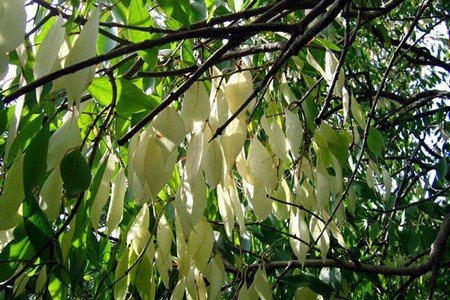

If you need to grow a lone tree, Maak's euonymus will do. This species loves sunlight and does not tolerate shade. For European varieties, the shade of mature trees will be the best place.
For a hedge, you should purchase Sakhalin or sacred euonymus. These plants give root branches and are ground cover plants.
The soil under the euonymus should be light with an alkaline or neutral reaction. The plant does not like clay, it is grateful for mineral fertilizing.
Watering the bush should be moderate. All euonymus do not like stagnant moisture and high ground waters.
Types and varieties
The plant euonymus forchuna and its species are used as a ground cover and as vertical gardening. There are more than 200 species and varieties of shrubs. The most famous and demanded:
- emerald gayeti. A frost-resistant ground cover bush reaches 25 cm in height. The leaves have a dark green color with a white border.
- harlequin. The dwarf ground-bloom shrub is shade-loving, susceptible to frost. White interspersed with yellow and pink flowers.
- Esmerald Gold. It is used for vertical gardening. Emerald gold color. Frost-resistant and sun-loving look. Reaches 200 cm in height.
Read also: Echinacea: popular plant species
Breeding Beresklet
Reproduction of spindle trees in natural conditions occurs due to the transfer of seeds by birds. The berries are poisonous to humans, but they serve as food for birds during the winter months.
Under cultural conditions, it is easier to propagate by root layers and cuttings from spring - the classic methods. To do this, in the spring, lignified cuttings are rooted in a greenhouse, planting developed plants in the ground in August.
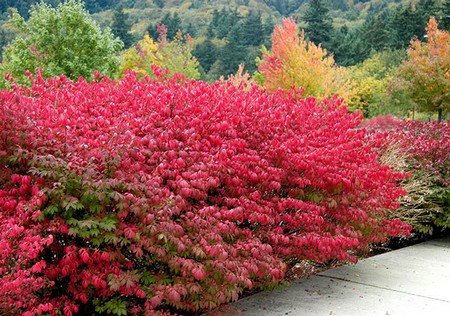

An easy way of breeding is to root the branch in a hole. Since euonymus tend to release roots in internodes, the twig is pinned to the soil and a small area is added in which roots are formed. Later, the branch is separated from the mother bush. In landscape design, euonymus in autumn, as in the photo, is irreplaceable.
He reminds with his victorious color that life is eternal and there is no reason for despondency. Autumn has its own colors. And the gray cloudy day is getting brighter. Designers like to use in the exposition free-standing trees, dressed with multicolored leaves, bright bunches of berries.
Undeservedly forgotten, euonymus reappeared in the landscape design of estates.
Preparing for winter
Despite the good winter hardiness of the shrub, young bushes still need to be covered for the winter. For this purpose, fallen foliage is used, filling the shrub with it completely, or burlap, with which the euonymus is closed from above. The plant will winter in this way for several years after planting. In the future, shelter is not required, but the winter hardiness of a particular variety of euonymus should be taken into account when preparing it for wintering.
Fortune's euonymus is an ornamental evergreen shrub, thanks to which you can decorate your site. The high decorativeness of the leaves, combined with ease of care, allows this plant to gain popularity among gardeners and landscape designers.
Photo
The photo shows "Fortune's eonymus":
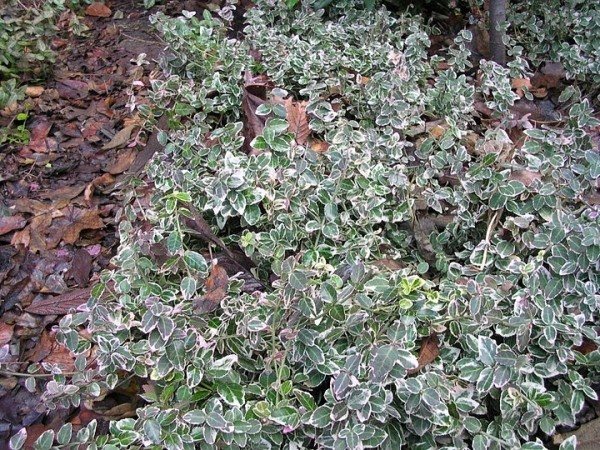

History of origin and legends
An evergreen shrub called the Forchuna euonymus is a representative of the eponymous family of the Bereskletovs, which contains more than two hundred different species. Among them are deciduous and evergreens, which are of great value to landscape designers. A distinctive feature of euonymus is its extraordinary color of foliage, as well as the ability of branches to quickly braid supports, creating living compositions.
There are two legends describing the origin of the shrub:
- The first one says that the creator of the euonymus was an evil sorceress who was angry with people and wanted to take revenge on them by creating a poisonous plant. But at some point, she took pity on the person, as a result of which the bush became medicinal. The witch herself turned into a robin bird, which, as you know, is not afraid of euonymus. Knowing about this legend, people began to call the fruits of the shrub "robin berries."
- The second legend tells that the history of the origin of the shrub goes back to the time of the creation of all plant life on Earth. Having lost a precious earring and a brooch, the goddess Flora did not go in search, but simply made a plant out of jewelry. And given the fact that they were scattered in one place, the shrub received an interesting feature: in the springtime it blooms with dead flowers, and in the fall it becomes covered with earrings.
As for the official data, China is considered to be the birthplace of the euonymus. For the first time, the plant was described by the research scientist Robert Fortune, by whose name it is still called. Translated from Latin "E uonymus" means "beckoning with beauty."
Varieties
Of course, those euonymus that are most often planted in gardens today are hybrids specially bred in breeding factories. Over the years, a lot of these have been created, so we will tell you only about the most popular ones.
They can differ in almost everything - the color of the foliage, the height of the shrub itself, winter hardiness and other characteristics.
- Emerald Gold - the height very rarely even reaches 30 centimeters. But it has very beautiful leaves - by themselves they are emerald, and around the edges are cast in gold. In autumn, the leaves turn completely golden - it looks unusually beautiful. The variety is winter-hardy, even to severe frosts.
- Emerald Gaiety is another "dwarf" euonymus. Bushes 20 centimeters high are very compact - you can plant them even in an apartment. For most of the year, the leaves are emerald in color, turning pinkish in autumn. It does not tolerate frost very well, it is better to plant in warm areas.
- Silver Queen is another small shrub up to 20 centimeters high. The leaves are the same as in the previous variety, but this one grows especially strongly and quickly in width. Winters well.
- SunSpot is a good option if you don't need a ribbon or carpet, but just bushes - this variety does not grow at all, but it creates very beautiful small bushes.
- Vegetus shrub is even lower than its predecessors - the height does not even reach 15 centimeters. It grows in width very quickly, it is suitable specifically for living carpets - and its creation requires almost no human participation. The leaves are dark green, with white veins, the shape is oval.
- Emerald Gold Emerald Gaiety Silver Queen Minimus (Baby) - the smallest variety, the height of the bush is 5 centimeters. Also has small leaves and thin shoots. Despite its modest size, a plant that is very necessary in design - you can make wonderful slides and rockeries.
- Coloratus is a medium-sized species with a height of about 40 centimeters. Rises well and clings to supports.
- Canadale Gold is the highest variety, reaching 60 centimeters. The leaves are very light, almost white, with multi-colored blotches. Grows in shaded areas.
Comments (2)
Larissa
09.11.2019 at 07:38 |
Decorative crown, the main advantage of this plant. Moreover, from such a "hat" you can form different shapes and even designs with pruning shears. And the simplest thing is, you can use this shrub to grow a hedge between different areas in your household.Reply
Julia Expert Plodogorod
10.11.2019 at 21:12 |
Hello Larissa! Fortune's eonymus is often used in landscape design. A very high hedge will not come out of it, since the bushes usually reach a height of 50-60 cm.But it is also quite possible to decorate a plot with them or mark the border of the territory.
If you need to create just such a composition, it is worth placing the plant denser than with conventional planting. One-lane and two-lane landing techniques are used. In the first case, the plants are placed at a distance of 25-35 cm from one another. If it is decided to plant two rows, you need to arrange the holes with a checkerboard. At the same time, the bushes should not be closer than half a meter from each other.
Although with the help of pruning it is really possible to give the desired shape to the euonymus, you need to carry out this event carefully and in a sparing mode. For the first time, you can trim the bushes only 10-11 months after planting. If you want to get dense and dense thickets, you can trim the center conductor. This will give an impetus to the growth of the lateral branches.
We also recommend removing the root growth. It can contribute to excessive thickening of the vegetative mass, which is fraught with disease. In addition, such sprouts draw nutrients and moisture from the soil. This can affect the decorative effect of the entire composition.
Mature plants can be trimmed with less caution. As a rule, such a culture reacts well to a haircut and begins to actively grow in the future. But, we want to note that more than 30% of the vegetative mass cannot be removed at a time. Otherwise, the bush may get sick as a result of a decrease in immunity.
Also, all work should be carried out only with clean and disinfected instruments.
We recommend that you carry out pruning work in early spring or at the end of fruiting. In the period of active development, only sanitation pruning is possible. Removal of weak, dry, pest-infested or disease-infested branches.
While this beautiful evergreen hedge can beautify any garden, there is a drawback to this planting option. The lower parts of the plants become bare rather quickly. Therefore, we recommend that you foresee in advance a place for planting another row of some kind of decorative culture, which will hide the indicated flaw, as if it forms an undergrowth.
When planting and forming a hedge, we recommend taking into account that this plant in the first 3-5 years of life requires wrapping before the winter cooling. The area near the rhizome can be mulched with sawdust or deoxidized peat. The crown can be covered with agrofibre. If the winters are very cold, we recommend taking several layers of spunbond or supplementing it with spruce branches.
Leaves, grass or branches for mulching and shelter should not be used. In such materials, harmful spores, bacteria and pests often hibernate.
Reply
Landing
- Euonymus of any variety reproduce very easily simply by vegetative means. That is, by offspring or cuttings. Both those and others perfectly take root in our climate and do not require complex care.
- First of all, choose a place - it should be lit, but not in the path of direct sunlight - they are just harmful and can dry out the plant.
- The soils are fertile and slightly moist. Too much water can kill a flower, so swampy soils are tidied up first.
- Then you need to dig a simple planting hole. Plant the plants, bury them immediately, compact the ground and water lightly.
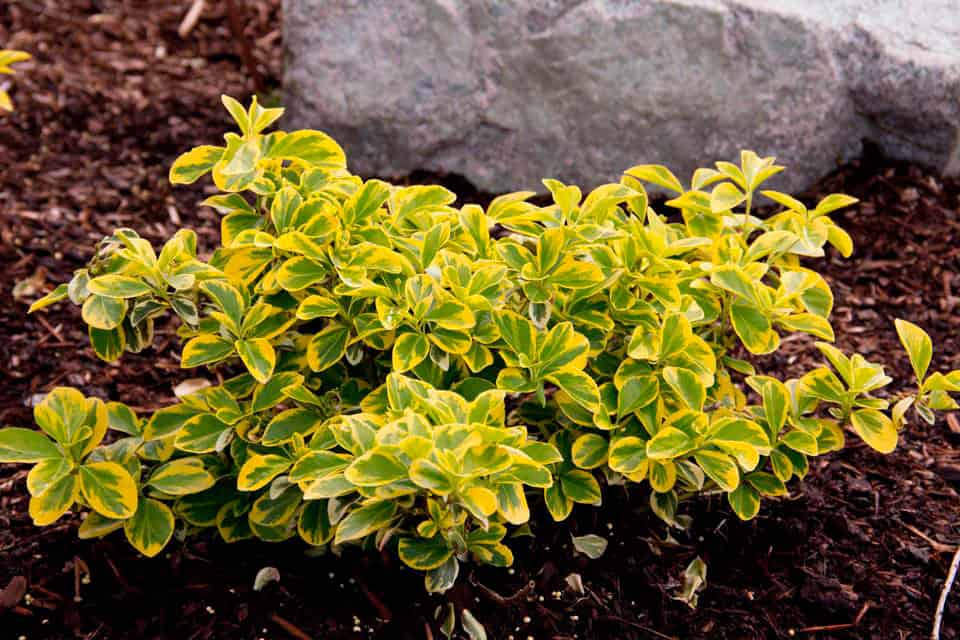

What is the Fortune bush
Fortune's euonymus in landscape design occupies a stable position due to its unpretentiousness and originality. At its core, it is an evergreen weaving shrub with very beautiful leaves, used to decorate flower beds and adjoining territories. It got its name from the name of the scientist who discovered it in China and described it - R. Forchuna.
On a note!
The Latin name for the bush is translated as "beckoning with beauty."
The euonymus reaches a relatively low height - about 0.6 m, but it can spread up to 3 m in width. From the nodes formed on the creeping branches, the shrub takes root. This allows the plant to trail not only along the ground, but also along the supports.
Closely spaced, dense, bright, most often two-colored, leaves create a fairly dense crown that has a high attractiveness. The leaves themselves are quite small - up to 60 mm in length. In the middle lane, the plant does not bloom.
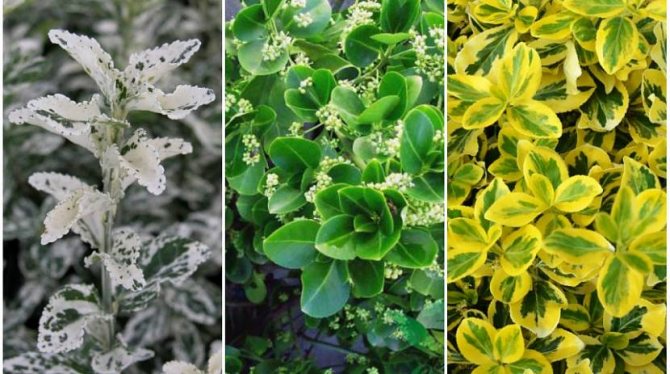

The appearance depends on the type of shrub
Advantages of Fortune euonymus, thanks to which this plant is used for landscape design:
- evergreen perennial;
- slow plant growth does not require frequent pruning when forming a bush;
- daily complex care is not required;
- frost resistance;
- there is an opportunity to start the plant on the support;
- no annual transplant required;
- good compatibility with other plants, especially conifers.
- in landscape design, Fortune's euonymus can be the central element of the composition.
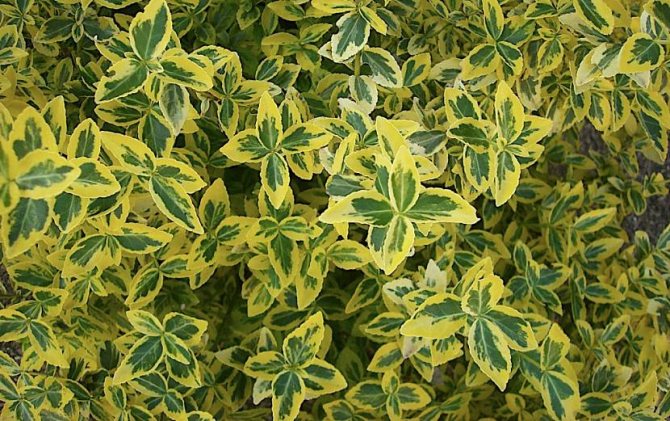

Emerald in Gold grade
What you need to know about euonymus
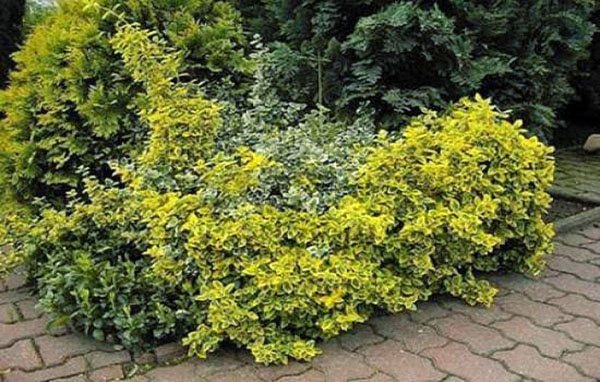

For landscaping, cultivated forms of plants, dwarf varieties and shrubs are used. Where it is cold in winter, lonely plants are grown in pots and tubs, storing them in a cool place for the winter.
In nature, euonymus grows under the canopy of trees. With a bright sunny color, the decorative effect of the leaves is lost. The best temperature for a plant is 18-22 degrees. The warmer, the more often you need to moisten the leaves and clod of earth. If the euonymus is to winter outdoors, its branches need protection. It is best to make a fur coat for the bush from the spruce branches of coniferous trees.
The plant is poisonous. Only 35 berries for an adult is a lethal dose. You cannot plant it in a place accessible to children.
Reproduction
Evergreen euonymus is most often propagated by root suckers or layering, less often by cuttings, grafting and seeds.
Root offspring dug up in the spring and transplanted to a permanent place. To obtain the shoots of the mother plant from the euonymus, they are covered with soil, they easily root, after which the daughter bush with a developed root system is cut with shears and transplanted to the chosen place. Dwarf euonymus and Japanese can inoculate on the European euonymus, then you get a decorative weeping form, which will have to be taken care of in the fall so that it does not freeze out.
For cuttings euonymus in June-July, young elastic cuttings 4-6 cm long are cut off. For their rooting, a film greenhouse is used, planted in a fertile substrate, which consists of leafy earth and sand (3: 1), sprinkled on top with a layer of sand of 5 cm.
It is more difficult to propagate euonymus by seeds, because they do not always ripen and can only germinate in the second year. Freshly harvested seeds are cleaned from seedlings and treated with a pink solution of potassium permanganate. When sowing in autumn in moist soil, they are covered with foliage or straw. If sowing is delayed until spring, then stratification is needed. Seeds for 3-4 months. stored at a temperature of + 10 + 12 o C, and then transferred to a warmer room (where 0 + 3 o C) until the sowing date. The mixture for sowing euonymus seeds consists of leaf, turf, humus soil and sand (4: 1: 2: 1). Seeds are sown to a depth of 2-3 cm.
Photo: Alla Kuklina, Rita Brilliantova, Maxim Minin
Preparatory stages
If you want to start growing euonymus, you need to allocate the optimal time for planting activities. According to experts, the best time for planting shrubs is April-May. During this period, the weather conditions are already quite favorable, so the young seedling will be able to finally get stronger and stock up on the necessary strength before the onset of winter cold weather. Often, gardeners start planting in the fall, but this method leads to the emergence of risks of death of the culture.
For the landing to be successful and give the expected result, you need to follow the following step-by-step guidance:
- In a previously prepared area, a recess or trench is dug, depending on the expected composition.
- The size of the pit should exceed the volume of roots with an earthen clod by 1.5-2 times.
- Place a 15 cm drainage layer at the bottom of the groove. Otherwise, moisture stagnation will lead to root rot and the development of dangerous fungal diseases. Broken brick, gravel or expanded clay are used as drainage.
- The excavated soil is thoroughly mixed with sand, humus, peat or mineral compounds, after which the seedling is placed in a hole at the same depth at which it is in the container.
- The seedling must be buried by compacting the earth around it. It is also important to arrange a place for watering and thoroughly water the euonymus.
- Another important step in planting is mulching the trunk circle, which will reduce the percentage of moisture evaporation. Peat, sawdust or fallen leaves can be used as a layer of mulch.
Nondescript flowers and globular fruits
In mild climates, the plant blooms with small yellow-green flowers. They are not very decorative, therefore they are lost against the background of variegated foliage.
The fruits of Fortune's spindle tree are not as bright as, for example, the taller European spindle tree. But even these small berries can make the shrub even more attractive. In addition, they remain on the plant until winter.
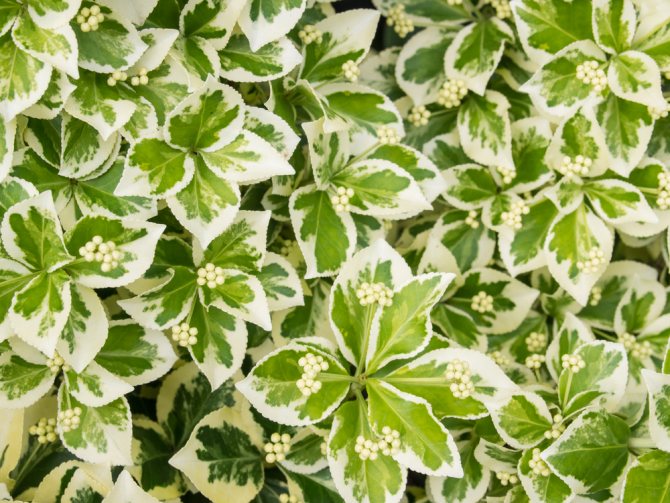

In the unstable climate of the middle zone, Forchuna's euonymus rarely blooms, so you can not wait for the fruit. But if you are still lucky enough to observe this beauty, do not forget that the berries of euonymus are poisonous.
Fortune eonymus - description and varieties
An evergreen shrub is found naturally in China, however, it is successfully used and grown to decorate gardens in regions with colder climates. The plant can withstand winter frosts down to -25 degrees.
Fortune's euonymus is distinguished by its numerous creeping shoots, which are covered with beautiful shiny, elliptical leathery leaves up to four centimeters long. The color of the leaves depends on the type of plant:
- The Fortune Emerald Haiti euonymus is a compact shrub up to twenty centimeters high. Its green, ovoid, irregular leaves up to two centimeters long are distinguished by a white border.
- The Sunspot variety is a slow-growing dense shrub up to twenty centimeters high, the stems of which are strewn with egg-shaped leaves up to two centimeters long. A feature of the leaves is a narrow golden ellipse located along the axial vein.
- Fortune euonymus Emerald Gold - a plant up to thirty centimeters high, widespread among gardeners, is distinguished by bright emerald leaves with a yellow-golden edging. In autumn, the foliage of the plant turns reddish-brown. Holly leaves grow up to two centimeters in length.
- The Malyutka variety got its name for its miniature size. It has thin, threadlike shoots and elliptical, whole-edged leaves only one centimeter long.
- Euonymus Vegetus is a small shrub with rounded large leaves and thick shoots. Dark green matte leaves are distinguished by white veins and a border.
- The Gratsilis variety is a shrub with shoots up to one and a half meters in length, on which yellow leaves grow.Over time, the middle of the leaves turns red, and the edges turn white.
- The Silver Queen euonymus is a creeping shrub whose stems are from fifty to eighty centimeters long. As a result, the crown of the plant eventually reaches more than a meter in diameter. It has bright green leaves with a white border, which differ in that with the onset of cold weather, the white border acquires a pink tint.

